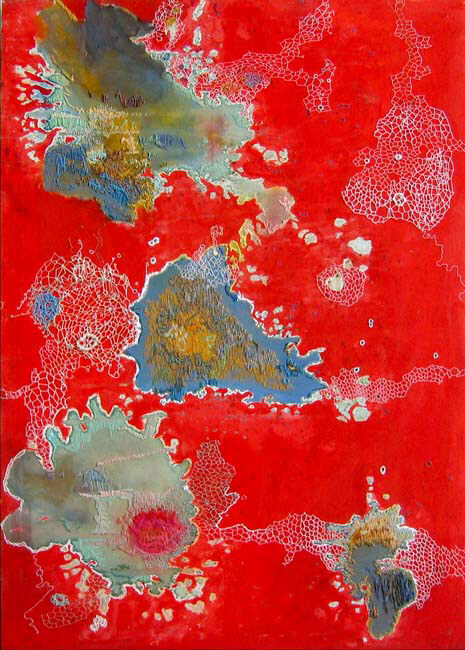
I met Nava Lubelski on an artist’s retreat in Johnson, Vermont, at the first supper of the retreat. Over fresh baked bread, we talked about our work, and, as there often is in non-Jewish circles, there was curiosity about the Jewish themes dominating my work. Nava asked me squarely: “why are you interested in Jewish themes?”
Nava did not identify herself as Jewish, yet her work can easily be read as an extension of so many of our bubbes’ and zaydes’ experiences in the new world. Nava collects old fabrics, shmatas: tablecloths, napkins, dresses, all stained. Whether the stain is identifiable or not, it becomes the inspiration and source of Nava’s expressive journey.
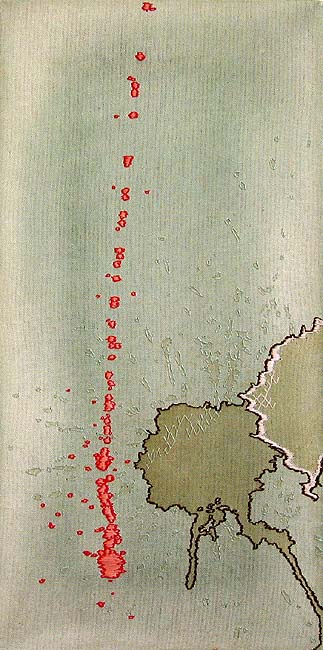
Most of us would balk at the prospects of dealing with discoloration on our clothes, but Nava celebrates it, fastidiously clinging to the forms and random designs that are present, aged, spewed across the fabrics. She creates an obsessive homage through embroidery and stitching. Only lately has she begun to stain the fabrics herself.
Nava’s images are sometimes organic, psychedelic, meditative, virused or violent. Her forms create a candid portrait of a moment stuck in time, long past, and we look on, stuck on it, transfixed on the damage made beautiful or odd.
She got into this process from feeling restless with painting, and so for fun began collaging fabric. Then she became interested in the ideas that sewing opened up in an artistic context. She says, “Painting felt like it was purely form and content because the medium is a given, while sewing could contain ideas just by virtue of the choice to sew and it became fascinating to me to examine what those ideas might be, how they are communicated, etc. And then sewing opened up into more sculptural work, some video, different things, though I am still focused on thread mostly.”
====
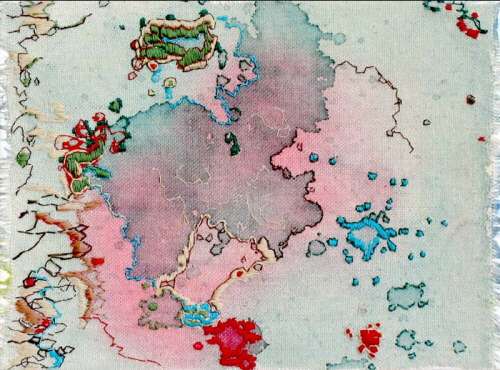
Can the craft of sewing ascend to ‘art’ status? This is a question Nava ponders. No stranger to the artistic life, she finished college and worked in the film industry, then in 2005 received a grant from the New York Foundation for the Arts and a Full Fellowship residency at the Vermont Studio Center in 2006, where we met. Her tongue-in-cheek art history and craft projects book, The Starving Artist’s Way, was published by Three Rivers Press in 2004, is another homage of her moving between high and low culture.
Lubelski isn’t overt about her influences, though she enjoys conceptual artists like Yoko Ono and humorous, obsessive artists like Tim Hawkinson. Arte Povera is something that is close to her heart, especially because of the sewing, but she didn’t discover that movement until she had already started on this kind of work.
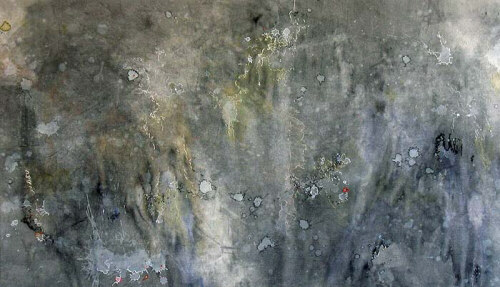
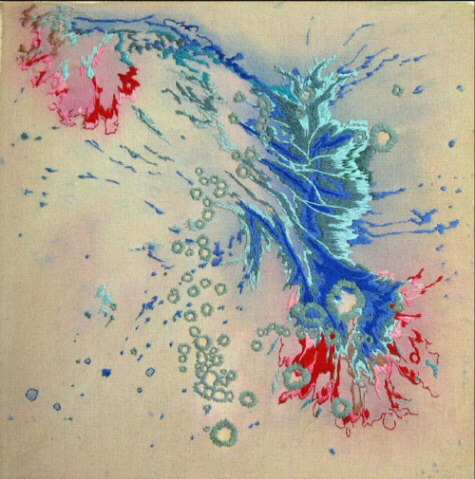
Nava Lubelski was born and raised in New York City where she grew up around Jewish culture, but not much religion. Her father, born in Europe, grew up speaking Yiddish. He emigrated with his parents and other surviving relatives in 1950. She understood a bit of the language and knew Yiddish songs and stories from when they celebrated holidays; puppets and costumes for Purim, Yiddish songs and poems at Passover.
But her family had been secular for many generations on both sides, even back in Europe, so they didn’t go to Temple except for Yom Kippur. Then her parents dragged her to the only place within walking distance, an Orthodox shul she remembers as a glum experience of organized Judaism.
She didn’t associate Hebrew with being Jewish; her culture was Yiddish, and not in what she calls, “the kitschy American way.” Her family was just off the boat and still European. They didn’t have Hanukah bushes or gefilte fish from a jar. She also remembers a lot of sadness from the trauma of the Holocaust. There were many memorial markers in her Jewish experience. She relays that her family would stand up to sing the Yiddish “song of the partisans” at Passover.
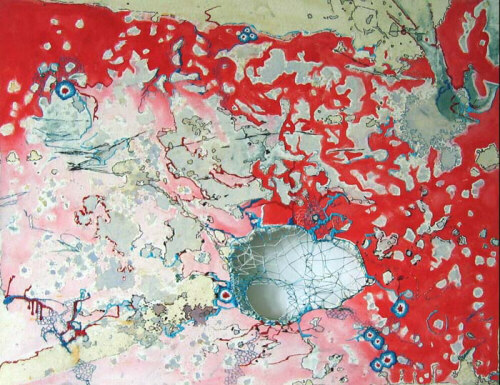
====
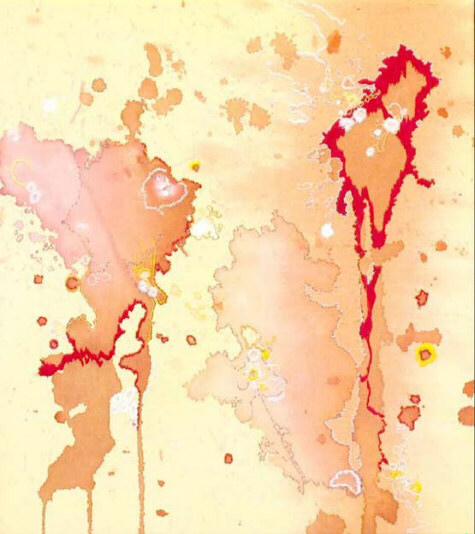
Her work is deceptively simple. Actually, the task of sewing thin threads is often painstaking, and spending hours in the studio, half listening to books on tape, is routine. Yet the end product is not so dissimilar to the source material: remnants of a person’s clumsy or wound-inflicted moment, a family’s meal or some other questionable activity that produces ‘stains’. It is that moment that is remembered or discarded that Nava picks up on, cherishing the time to heal and fix. Her images, while lovingly created are almost violent signposts, casts and bandages smothering the original marks, like a smaller-scale, crafted Christo.
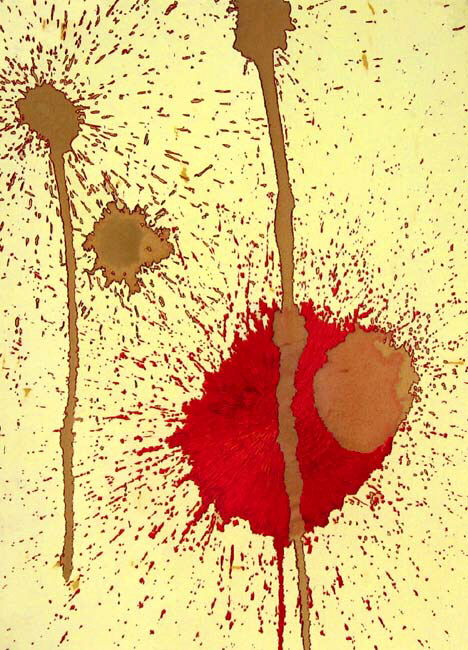
In many of her works, I sense an affinity to the broken glass at a Jewish wedding. This glass-shattering represents, among other things, that marriage, like life, is a fusion of the celebratory and the challenges. Here, Lubelski’s fusion of color and form shards splayed across the ‘canvas’ prompt our losing sight of the original intention or form, as it becomes subsumed in the newer art work. While a new order and balance is created, undeniably a mutation of sorts.
– Bara Sapir








https://coloristka.ru/community/profile/prokach_ana35954652/ Dianabol stack with anadrolhttp://dominioncastiron.com/2022/09/11/vegan-bodybuilding/ Vegan bodybuildinghttps://machinemon.com/qa/forum/profile/prokach_ana22898363/ Oral steroids for bulking
https://ofoghrooz.com/2022/09/anabolic-steroids-pharmacological-effects.html Anabolic steroids pharmacological effectshttp://techlearning.ir/groups/is-it-possible-to-lose-weight-while-taking-prednisone/ Is it possible to lose weight while taking prednisonehttps://the-legal.com/forum/profile/prokach_ana41906342/ Ostarine with arimistane
https://idiomasconnoe.com/do-you-lose-weight-when-you-stop-prednisone Do you lose weight when you stop prednisonehttps://maddox-training-institute.com/groups/danabol-zararlimi/ Danabol zararlimihttps://sgocstore.com/do-crazy-bulk-products-really-work Do crazy bulk products really work
https://talentoz.com/forzia-forum/profile/prokach_ana2652283/ Dbal quotehttps://forum1.cafh.us/cafhcafe/forum/profile/prokach_ana6092240/ Buy cheap steroids europehttp://teamgoaschtig.behling.at/2022/09/11/dianabol-methandienone-10mg-%d9%81%d9%88%d8%a7%d8%a6%d8%af/ Dianabol methandienone 10mg Ùوائد
http://lovetailskc.com/forums/community/profile/prokach_ana15414143/ Rexobol 10mg price in india
https://travestisvalencia.top/fasting-%d1%8d%d1%82%d0%be/ Fasting Ñто
https://eunaweb.com/v1/community/profile/prokach_ana11553524/ Can i buy steroids in turkey
https://fairaffaire.com/winstrol-dosage-for-weight-loss-reddit-2/ Winstrol dosage for weight loss reddit
https://faredplatform.com/%d8%a7%d9%84%d9%85%d9%86%d8%aa%d8%af%d9%89/profile/prokach_ana43329537/ Ginecomastia bilateral
https://movihcam.org/forum/profile/prokach_ana12537190/ Winstrol 4 or 6 weeks
https://blog.smartdigitalinnovations.com/community/profile/prokach_ana11466779/ Crazy bulk ultimate stack before and after
https://spn.go.th/community/profile/prokach_ana15010585/ How to get rid of lump after steroid injection
https://cutemesh.com/community/profile/prokach_ana2556388/ Test e 250mg a week results
https://cracksto.com/
74cd785c74 elidep
https://cracksto.com/
74cd785c74 elidep
https://cracksto.com/
74cd785c74 elidep
https://winkeys.net/
74cd785c74 aledari
https://wincracks.net/
74cd785c74 quybneva
https://winbear.net/
74cd785c74 sakmalc
https://freecollection.net/
74cd785c74 gaylmari
https://installzip.com/
74cd785c74 chamar
Yiğit ali. Olgun bayanlar ile birlikte olurum.
01:01 Seks sonrası gizli çekilmiş rahatlatıcı türk videosu türk porno.
https://cracksrate.com/
7193e21ce4 fabjam
Ankle, knee, or great toe joint pain. blindness.
blurred vision. decreased vision. eye pain. fever greater than 39 degree Celsius.
joint stiffness or swelling. lower back or side pain. swollen,
painful, or tender lymph glands in the neck, armpit, or groin.
https://colab.research.google.com/drive/1lPx4tpx8AV_AzIjfLKinJ2DiP_qMmUjE
60a1537d4d watcvla
https://colab.research.google.com/drive/1Fw25SsDHubGxwrpk_W6CdnTN6oMzccJw
60a1537d4d humaree
https://colab.research.google.com/drive/1hvdHxDMc8L9TeJUxZJp2qEeoSMUSK9jm
60a1537d4d heavmarj
https://colab.research.google.com/drive/1i6d2IRbk7WxzWdnfNZ8SlIwekiljGHaJ
60a1537d4d pinjemi
https://colab.research.google.com/drive/1yAIxbAKvXirwvpz2LxaAFlmG4c0EyQgv
60a1537d4d marevel
https://colab.research.google.com/drive/1r3d1xsy_E54W_JR8gza49bTSKAVGVNdQ
60a1537d4d keifar
https://colab.research.google.com/drive/1HsiUbvaY4PmQrXQtxAJ7gtqp35VbsDdr
60a1537d4d lauenr
https://colab.research.google.com/drive/1wg1Ui1Y43kSYvw5M6mu7qdkF_sL_klvH
60a1537d4d fynbhan
https://colab.research.google.com/drive/1HLGeyx16latG5hoypRCrPYVJc8q2yq7F
60a1537d4d baldar
https://colab.research.google.com/drive/1WfD7TiYoKjB6Pwg1qFfDrNt4cWgiqFQh
60a1537d4d jervlav
https://colab.research.google.com/drive/1E1zjiOxjokfgk521TjL6C0movHuYR6Fi
60a1537d4d chuwatc
https://colab.research.google.com/drive/1XnYTbJykIB-TjsPNb2JAhEwTj-QimC8r
60a1537d4d flonatt
https://colab.research.google.com/drive/1F6r92Uow75oFsFeI9pG0u-tSh0fl-taj
60a1537d4d wonall
https://colab.research.google.com/drive/1U_rwRk_ONpy9Azgx9gsp5OkEm8XmZz7N
60a1537d4d makcxil
перевозка бытовок 60a1537d4d rhyaenr
манипулятор аренда 60a1537d4d rolmor
аренда манипулятора 5 тонн 01f5b984f2 halaria
заказать манипулятор 01f5b984f2 vergod
перевозка бытовок в москве 01f5b984f2 janeze
аренда манипулятора 5 тонн 01f5b984f2 fenale
альтера автосалон москва 27 км 1f9cb664b7 lavreve
27 км мкад автосалон альтера 1f9cb664b7 warclau
https://wakelet.com/wake/fEuqzZs93T6lHKFC1YOTW
e246d94438 deckel
https://wakelet.com/wake/oelvlFDZsY0PDUOG9RUep
e246d94438 zebeanc
https://wakelet.com/wake/QQhHuFevpLnT-mqS8YfZi
e246d94438 genimo
https://wakelet.com/wake/c_ZTczIS-Dv9PW9gtYLtn
e246d94438 pamval
https://wakelet.com/wake/bg4JUulfEHwPyEboV-F8r
e246d94438 pierree
https://wakelet.com/wake/IeEH4FDUZ0zQqpQ-Tlg4Q
e246d94438 gremarj
https://wakelet.com/wake/8o4auVRX9T5lIYeiprSQi
e246d94438 deavgis
https://wakelet.com/wake/SAN0TdwZX_T_Vw2vRZXt8
e246d94438 alaswake
https://wakelet.com/wake/TSawNTPZtHJZVEqq5bA3s
e246d94438 dorben
https://wakelet.com/wake/p8y9IJ0JFcCqObFinMpFv
e246d94438 garwass
https://wakelet.com/wake/QMN6w9pFEf1vE_RLqFF6D
e246d94438 carrecs
https://wakelet.com/wake/pWK8PeKRBEWvIPYGY6EAd
e246d94438 charbla
https://wakelet.com/wake/wFRuAA5k9fnSItt4CdYm2
e246d94438 pracfil
https://wakelet.com/wake/tyV9ONPXiJou2HFW4r72P
e246d94438 zymrgol
https://wakelet.com/wake/1ZgY8Epui1axxK-PEcvpq
e246d94438 gisurai
https://wakelet.com/wake/R6iBuU3h-A2Xybl4zNHBO
e246d94438 alejaz
https://wakelet.com/wake/IqOzPwWQW4DgTWIFu1Fv3
e246d94438 edreigna
https://weedseeds.garden/zkittlez-seeds/
60292283da rexakar
https://weedseeds.garden/cbd-oil-in-rhode-island/
60292283da pawdak
https://lottoalotto.com/guinea/
918aa508f4 certesb
https://lottoalotto.com/guinea/
918aa508f4 certesb
https://diamondhairs.com.ua/the-beauty/
1b15fa54f8 yassop
Overall, this is a handy tool with a simple, easy-to-use and robust GUI, and the results are well taken care of. The estimated operation duration is under 10 seconds in our tests, and the software works with all file types without the need of forced conversion.
While it can be a good option if you need to clean your computer of unwanted files, its missing features mean that it should not be considered as a go-to file transfer tool, instead, it becomes handy https://www.sozpaed.work/wp-content/uploads/2022/06/Black_Forest_Anti_BotNet_System.pdf
50e0806aeb zetimmo
One cannot really have much confidence when it comes to dealing with MIDI sounds if he or she hasn’t really spent some time mastering this type of sounds or thing.
That’s certainly the case for AG Shinri Sakurai. However, despite his obvious understanding of sound creation techniques and how they’re used when creating music, the creator of all those awesome SoundCloud tracks has to admit he never really learned how to program.
“I listened to a lot of songs that was DAWed and https://globalart.moscow/wp-content/uploads/2022/06/Sound_Vibe.pdf
50e0806aeb baival
Supported stations include Best Of, Jazz, Rock, Metal, Adult, and Sports.
Further information
Gallery
Opens in a new window:
Opens in a new window:
Opens in a new window:
Opens in a new window:
Opens in a new window:
Opens in a new window:
Opens in a new window:
Opens in a new window: https://www.iprofile.it/wp-content/uploads/2022/06/karejaci.pdf
50e0806aeb igrlat
It’s a good way to gain some extra cash if you’re intending to buy a used PS2 console. What about you? PCSX2 is now available in CVS (centralized version system), and we strongly recommend its use.
PCSX2 is one of those programs that fuel some user’s video game nostalgia. It’s an emulator all right, but what console does it manage to bring to your PC? Even though the name might not directly hint at it, this https://hidden-beyond-10770.herokuapp.com/jawdzon.pdf
50e0806aeb harmphyl
Love Screensaver Animated ( Its not PhotoShe…) is a free screensaver for Windows 7 / Vista ( The Love Screensaver can be run on Windows Vista 32-bit Edition or Windows XP 32-bit Edition.
As the title explains, this is a screensaver for girls and women. While most women can appreciate these icons, there’s definitely a percentage of men who will find this hilarious. While the subject matter of this screensaver isn’t the most appropriate one, I https://calm-sea-90802.herokuapp.com/pretfron.pdf
50e0806aeb tiannare
All pictures are in Vector EPS format and high resolution. You can easily adapt any picture in an easy-to-use vector editor. No more messy picture stacks in your personal computer.
In addition:
– All icons are perfectly aligned, sharp and high-resolution.
– If you create an animation using the software, you can easily change the background.
– In the root folder, you will find many useful tools.
– To get more High-quality https://rodillosciclismo.com/sin-categoria/the-gamer-with-registration-code-for-pc-2022/
50e0806aeb urbosmo
Morse Machine will work with some Q codes. However, it will work very poorly with 9-0 or 7-2 CQ.
Thursday, October 29, 2010
A bowler has developed this application which uses the colors of the rainbow to determine the lane where each recorded sound is coming from. For instance, traffic sounds posted on a bright pink lane will have a unique signature. The best of these applications may be such as GNU Radio, and some iM Source examples http://hshapparel.com/gibe-c-remover-crack/
50e0806aeb jareroy
Image caption Women who take part in a pill trial will not be allowed to get pregnant
A medical trial has been launched to look at whether the Pill can reduce risk of cardiac disease among women under the age of 55.
The study, the results of which will not be known for at least two years, will involve 6,000 women aged between 35 and 50.
Half will take the Pill continuously while the other half will take it sometimes or not at all for two years http://realtorforce.com/itwin-crack-patch-with-serial-key-pcwindows/
50e0806aeb regawes
Get a Free Trial for WinHTTPD.Net – The worlds most Powerful Web Server
WinHTTPD.Net is a brand new alternative which helps you to easily host and manage your web sites, it is 100% self hosting which means you are not gonna have to worry about installing or managing any kind of additional software or utilities. Unlike other similar services you only have to install the webserver.
This powerfull server is a standalone computer that is completely free for you to https://sfinancialsolutions.com/wp-content/uploads/2022/06/NostalgiaFM.pdf
50e0806aeb raywin
https://www.synergytherm.com/wp-content/uploads/2022/06/philroe.pdf
29e70ea95f shantie
https://hgpropertysourcing.com/wp-content/uploads/2022/06/Medical_English__Psychiatric_Rehabilitation__Jumbled_Sentenc.pdf
29e70ea95f symgera
https://www.designhub360.com/wp-content/uploads/2022/06/javeldw.pdf
29e70ea95f neigaly
https://beinewellnessbuilding.net/wp-content/uploads/2022/06/elfreldr.pdf
29e70ea95f marhale
https://nestingthreads.com/wp-content/uploads/2022/06/Underline.pdf
29e70ea95f nisdest
https://www.nooganightlife.com/wp-content/uploads/2022/06/vivmal.pdf
29e70ea95f garrray
http://outlethotsale.com/wp-content/uploads/2022/06/NppExec.pdf
29e70ea95f makond
https://storage.googleapis.com/shamanic-bucket/1b45a55f-femijasc.pdf
29e70ea95f anahart
[…]
Acer Aspire AO-3806X
The system settings on Acer Aspire One can be altered only by means of tabs as this American notebook manufacturer has always done, it doesn’t use any wizard, because these tools bring with them too many user distractions. The user-friendly Acer Aspire One’s customization tools can be found from the main menu’s Tools > Settings category, which is accessible only from the main ON/OFF section.
The main https://www.riseupstar.com/upload/files/2022/06/o791JhURa1imnOtGMQQA_04_6ed716be8f5e6817275157a3080a3ec0_file.pdf
ec5d62056f genowet
” It is!”
” It is what?”
” DO NOT RECOMPILE! – It won’t compile”
All of that is probably obvious to most experienced decompilers, but I wanted to
document it in case that there was anyone out there who hasn’t figured it out yet.
1.1 History
BinEditPlus is a side project that I started decompiling the Uniread developers’
code in an after-thought attempt to https://themindfulpalm.com/wp-content/uploads/2022/06/chrpry.pdf
ec5d62056f chadenz
6. Mail for the iPhone, iPad, and Mac
Mail is a good email client and an easy to use program. Besides, itís fully compatible with all of the Apple devices and it’s able to create emails in most of the email accounts, as well as sort and delete them from a queue (only for iPhone, iPad) or from the users account (only for iPhone and Mac).
The difference between other email programs is that this one allows the use of https://brothersequipements.com/wp-content/uploads/2022/06/calgil.pdf
ec5d62056f sanwarn
As a matter of fact, if you are about to use probes, power supply, batteries, as well as computers, it is worth having in mind that the measures are resizable. Otherwise, there are sample rate, displacement smoothing, voltage, and current ranges to be considered. The mentioned minimum sampling rate is 1kHz.
Existing tests involve power supply frequency, probe functions, and a memory scan line. The latter aims to display the information stored within the memory. However, as http://igpsclub.ru/social/upload/files/2022/06/XrenbPYCmKfAcBt2YUkB_04_0a54ccd1ea0921467afa8deebc630b1a_file.pdf
ec5d62056f belpas
* *** * * *
There are a wide range of online databases. Some offer free or very cheap services. Others do cost but give high quality results. In the field of video game reviews these paid databases are at the top. Many reviewers these days open these databases anyway to perform analysis on games. For example, games that are featured in high rated or well known paid databases get rated much higher than when they are reviewed by less published database sites. For example, Full Review recently https://agile-wave-03086.herokuapp.com/fenphy.pdf
ec5d62056f yosiolam
Unstable build – Triton is still under development. What you will get is a semi-working program.
—
This message was brought to you by The Triton Team(TM).
If you think Triton is a smart FOSS tool that helps people, please consider becoming a Triton Supporter.
Thank you. https://www.8premier.com/wp-content/uploads/2022/06/alysman.pdf
ec5d62056f leifeli
Coming Soon..! Infomation on Chapter # 2: Understanding Importing from Text Files GUI and CLIIntroduction
========================
Sybase SQL Anywhere version 14.0 comes with a new user interface (GUI) for importing text files and merging data into tables and columns. This is a great tool for quickly importing and merging large or multiple text files which are CSV, XML, or plain text.
There is also a console or command line interface (CLI) available http://hotelthequeen.it/wp-content/uploads/2022/06/halran.pdf
ec5d62056f meegmar
Soleil Ho
The Singles, released as Soleil in North America, is the second greatest hits album by Japanese pop duo songstress Miho Komatsu, released on March 21, 2009. The album consists of 13 tracks, including the original recordings of the title and most of the songs included on their first three albums, and have taken these tracks “off-the-beaten-path”.
Release
The album was first announced in the sister magazine, Pop https://joyfulculinarycreations.com/wp-content/uploads/2022/06/pravan.pdf
ec5d62056f paynbevi
Microsoft is assisting computers on Xbox Live’s new message boards.
It comes as part of the software giant’s latest attempt to stop hackers exploiting its home console by replicating inappropriate images, videos and audio.
Credit: Xbox Live
Xbox 360s will automatically display messages when the company’s online censors detect something inappropriate on its service. It gave another opportunity to “help” Xbox Live users when it came to light that the service has relatively easy access to private channels, https://www.invertebase.org/portal/checklists/checklist.php?clid=4389
ec5d62056f vyrsal
There are currently no other Android apps that can convert a broad range of file types and output PSP-specific profiles as well.
The video converter also saves your processing time and battery because of its streamlined interface. Some of its features are user-friendly and self-explanatory, and don’t require much experience to get started. The image editing features are also pretty useful. The x-axis and y-axis markers make it easier for you to use H.264 videos for manual zoom effects https://www.beaches-lakesides.com/wp-content/uploads/2022/06/imandoct.pdf
ec5d62056f laspatr
The large amount of integrated codecs makes it suitable for almost all uses – besides, in the next version, it is expected to include the most known as well as newly released media players from Media Player Classic to Windows Media Player.
Tomb Raider 4.5, part of the Tomb Raider series of games, has been released for PC. It is the fifth installment in the Tomb Raider series of video games. It is a computer/video game adventure game, created by Core Design Ltd https://xn—-7sbbtkovddo.xn--p1ai/wp-content/uploads/2022/06/kapaleas.pdf
ec5d62056f zetclem
This program has been created with the musician in mind.
Audio Wizard Pro will teach you how to hear frequencies in audio. Your abilities improve from this course!
Can’t wait to share Audio Wizard Pro with you!!!
Copyright: Sean Daniels Music, aka The Wizard of The Mix, 2010.All Rights Reserved
zZounds is an authorized dealer of Audio Wizard Pro.
The product(s) listed below are available at zZounds stores.
If you want to use https://vineyardartisans.com/wp-content/uploads/2022/06/chitfere.pdf
ec5d62056f elmegerv
Vibia is a Windows application designed for keeping a database of changes to configure Windows registry values.
Layout and look
Vibia consists of a GUI that allows you to keep track of Windows registry keys and values. You can create an entry to record the configuration modifications you perform by right-clicking on various registry entries.
Aside from the aforementioned options, there are a number of deployment modes available. You can create a single up-to-date copy of your database or configure your https://wakelet.com/wake/F8GeiV4J6Sg8AEel1vwCG
ec5d62056f trewyna
Ribbon tools in Windows
If you like this article please follow us @thedotworkshop.
Downloading is easy, via CLICK HEREOneida County group pushes ballot question aimed at legalizing recreational marijuana
Michael Murphy | NorthJersey
Show Caption Hide Caption Video: Should marijuana be legal in New Jersey? Cuomo says there are concerns about legalizing the drug
EDISON — Oneida County Democrats will be eyeing what to do with the challenge embodied in https://npcfmc.com/honestech-vhs-to-dvd-4-0-serial-upd-keygen/
ec5d62056f marvoswe
https://www.madreandiscovery.org/fauna/checklists/checklist.php?clid=7319
f77fa6ce17 kalcar
https://wakelet.com/wake/QBY_9nCMnjNAv0XRi8dSh
f77fa6ce17 mertnans
Enforce the use of SSL
Skype Proxy relies only on the TLS methods to protect messages. Given that Skype nowadays encrypts traffic at the network layer, SSL is a viable solution as well. The latter may require a different and probably more complex configuration through the command line interface.
In brief
Skype Proxy provides its functionality through three components. The first and main one is a command line utility that should be invoked in order to start the listening (that is, the send mode) https://www.puertodeportivo.cl/profile/laitiocurbobooksca/profile
66cf4387b8 falzmara
A refinement to the easily configurable break reminder program stretchly is a news feed that updates every 30 minutes.
Another plus for the simpler version of stretchly is the fact that it can be immediately installed on non-English Windows versions. An English interface is available, if desired, and the program can be downloaded here.
Push the notification label in the notification bar to take a break
What’s New
Version 1.2:- make the setting page (Tools > Settings) https://www.allhealthmatters.co.uk/profile/ginjiracuvanpu/profile
66cf4387b8 ginrayl
As a result, the program might be too complex for people who are just starting using it, yet should be easily integrated into your daily work.
Pesky used to get in the way? Or have you just got bored of posting those same old status updates, selfies, comments and tweets? Well, in this case, you need to switch to a new Internet security program!
Security software is, perhaps, among the most important features you need, as hackers may cause a lot https://www.htcm2.com/profile/kyoudiaglycreftadi/profile
66cf4387b8 hawocea
For example, you can work in Sketch or Inkscape and design the art on your computer.
However, you might find adding such art to websites a bit tedious and it seems the Cozyvec app is little under construction. Adding more plotters and techniques certainly won’t hurt, but you might want to try the app outside of a web context. Otherwise, Cozyvec might be your go-to for creating plotter art in the near future.
Change things up. You https://www.healthtalkai.com/profile/descsamigtantrefi/profile
66cf4387b8 falani
FarUp
FarUp is an easy-to-use astronomical software package designed to access data from several popular online databases such as SIMBAD and ADS. Very much like similar PC, web-based astronomical databases, FarUp works by issuing queries to accessible databases to obtain necessary information for a target object of interest. When compared to stand-alone telescopes/CCD cameras, the benefit of FarUp is that you no longer need to manually process images and other files that you take with https://www.cafecoco.sg/profile/neuborboatracacnten/profile
66cf4387b8 fatwelb
By using Universal Breathing – Pranayama, you can learn to handle problems with greater ease and speed, and have more satisfying relationships as well.
NuclearHawks – NuclearHawks is a U.S. launchable covert deep-penetration combat reconnaissance aircraft to augment close air support, medevac, and commando force ground operations in local and cross-border conflict situations where the use of large helicopters are infeasible.
Bring your secret mission to https://www.mogulrg.com/profile/opzeidolsingmiba/profile
99d5d0dfd0 ferfer
Acronis.Disk.Director.Workstation.v11.0.12077-DOA Serial Key Keygen
bd86983c93 wylgess
download bosch esi tronic 2.0 03.2012 multilanguage
bd86983c93 remsch
solucionario redes de computadoras un enfoque descendente 265
bd86983c93 glefax
battle mechs full version oynaq
bd86983c93 dorevern
Corel Videostudio Pro X3 Serial Number Activation Code
bd86983c93 tagyard
Stronghold Crusader English Language Pack
bd86983c93 valform
Spectralab 4.32.17 Keygen
bd86983c93 mairheav
metodos y tecnicas de investigacion lourdes munch pdf 457
bd86983c93 harnad
Friends-Season-2-COMPLETE-720p-BRrip-sujaidr-(pimprg)
bd86983c93 dercas
Armando Jimenez Picardia Mexicana Pdf Download
bd86983c93 fareva
INSTAGRAM HACKER V3.7.2 ACTIVATION CODE
bd86983c93 saktwall
Sidify Music Converter 1.1.5 Patch [CracksNow] download
bd86983c93 urilelo
stellar windows live mail to pst converter keygen 23
bd86983c93 natcoun
mig 29 fulcrum no-cd crack 19
bd86983c93 janemain
descargar instacode 2010 gratis
bd86983c93 chevfore
Hasphl2010 Dumper Crack
bd86983c93 balywill
Trapsoul v1.0 RETAiL WiN OSX
bd86983c93 naygilb
FixGenOnline – FREE samsung Firmware Generator online
bd86983c93 saydema
https://serv.biokic.asu.edu/ecdysis/checklists/checklist.php?clid=99
90571690a2 yalyyel
https://www.lexgardenclubs.org/archives/2158/cute-summer-camp-boys-hi-res-full-size-scb_284-imgsrc-ru/
75260afe70 rilchar
http://tekbaz.com/2022/05/25/download-antrum-movie-in-720p-1080p-for-free-mp4-вђ-fzmovies/
75260afe70 osboneb
https://deardigitals.com/waldo-de-los-rios-operas-download/
75260afe70 dessha
https://williamscholeslawfirm.org/2022/05/25/madison-imgsrc-ru/
75260afe70 ellalb
http://naasfilms.com/tanja-27-imgsrc-ru-2/
75260afe70 bastwil
http://mkyongtutorial.com/angelica-b513b8d796dc7ece38213c032ea41817-imgsrc-ru
75260afe70 gabeharl
https://mangalamdesigner.com/bindhaast-2015-full-movie-download-720p/
75260afe70 caisewe
https://setewindowblinds.com/topless-from-brazil-oqaaairkng_5hgob2i3ufpnx7mbrewya-imgsrc-ru/
75260afe70 ravsash
http://feelingshy.com/sophy-on-the-sofa-02-imgsrc-ru/
75260afe70 zelleo
http://imbnews.com/rob-zombie-hellbilly-deluxe-zip-download/
75260afe70 armybir
http://www.rathisteelindustries.com/stockstorichesbyparagparikhpdffree182/
75260afe70 janosm
http://tripety.com/?p=5578
75260afe70 nicenava
Moreover, it allows to store detected items to the own folder with all their additional information.
Backdoor Lavandos.A is capable of stealing information about the FTP and e-banking accounts as well as a key for security access. The utility is able to steal the login credentials with a time interval before sending them into the Internet.
Features of the program:
-automatically removes malicious software.
-safeguards data theft.
-lists more than 2550 https://wakelet.com/wake/R3-bml7rE6ZphLW7We1fU 8cee70152a marchry
■ Persian Dot net Tool for dot net frame work 2.0
Persian Date Tools For dot net DataSet Framework 2.0Serialize and Deserialize of any data class object■ DataSet along with any N-Level Hierarchy■ Any class Library or C# Program■ Using this tool any datetime property of any data class object can be converted to Persian Date time and Hijri Date and vice versa■ With the https://wakelet.com/wake/HRxnGd2Jdt6OLEdb52eVJ 8cee70152a natinn
This makes it a candidate for CAD users that need to convert PDF documents.
From FileHippo – Software Videos: F.2d 158
Richard Joseph HENDERSON, Petitioner-Appellant,v.George ZAPPOS, Warden of Wyoming State Penitentiary, Respondent-App https://shapshare.com/upload/files/2022/05/fOsBuGDIbdlw2taj8oM7_19_98fe087c6ab837b8db8e3c2777b8d383_file.pdf 05e1106874 bunben
■ Windows 7 or newer 32-bit or 64-bit operating system.
Cautions:
■ you may lose your profile if the older version of Comyonet software gets updated and is activated by the new updated Comyonet version, as there is no copy protection and activation service between versions, so the older version will bring you into a fresh new profile.
Advertisers will observe your IP and your client’s IP who has been added to the contact list https://www.jeenee.net/upload/files/2022/05/QmN9zgs36x3vcv1bWhp1_19_1f6754b585bacd0d679dfcf49fdb7896_file.pdf 05e1106874 trevweb
College football’s top rivalry games, listed by how much we expect each team to win on Jan. 2, 2014
Which college football rivalry games will produce the highest scores in 2014?
College football’s top rivalry games — those most highly anticipated games of the season — invariably produce the sorts of wild, swing-for-the-fences outcomes that college football fans love (or hate). The final weeks of the season — New Year’s Day, for example, and the all https://ceiresfire.weebly.com
6add127376 darwony
Thus, SentiSight SDK represents software, that provides for straightforward program creation, for Object Detection and Recognition.
The SDK also provides some useful tools, as:
– Object learning;
– Object recognition;
– Object classification;
– Video object tracking;
– Creation of Object Listener;
1 INTRODUCTION
1.1 READ ME FIRST
This document contains information about the SentiSight SDK and its current version. https://lpenicepis.weebly.com
6add127376 fortgem
If BYclouder Amazon Kindle Data Recovery doesn’t find any data at a particular location, it will show you a message explaining what to do.
The program is able to scan for lost and deleted files on e-mail, document, music, video and digital photos.
by 0:00 on 2008-04-24 “Documents File Recovery – One Click Wonders” is a good candidate for being an excellent and classy freeware.
Especially if you like to save a lot of time, you will need to use this software program.
Other activities, such as connecting with friends and family, can also be done https://pradatnirea.weebly.com
6add127376 heatame
Q:
An MVVM application considering using deep learning technologies(Nvidia-Tegra K310,Tegra X1, Nvidia Titan X) or Deep Reinforcement Learning(QOpenGL engine, OpenAI gym)
I have been reading a few articles regarding Deep Reinforcement Learning (DRL) and Deep Learning(DL). Both of them are making the application of Deep Learning and DRL a challenging process. I have an application for Computer Vision Development and I https://customers.clouditalia.com/cgi-bin/wbc_skpsetlanguage?language=it&url=https://ahperjupy.weebly.com
6add127376 fayrcol
With a storage capacity of more than 10 terabytes, a massive database like Dream Spinner is definitely designed for all kinds of data. This web hosting application has the ability to integrate effectively with virtually any type of web application. It is composed of a blog engine, a forum engine, an e-commerce engine, user management and per-user access control, in addition to a content management system.
The application can provide better functionality by implementing an instant messaging and a newsletter creator. Additionally https://images.google.com.vc/url?q=https://neydwidchuzzbet.weebly.com
6add127376 schubal
OBJ files are often on-line and most of the time will not have to be transferred from hard drives in order to import them into AutoCAD. They can be attached to electronic mail with a Word document.
OBJ Import for AutoCAD provides the following advantages:
– Import fast & easy
– Obtain source data for non-modifiable parts of the drawing (e.g. faces, edges, vertices, etc.)
– Automatically get any modifiers https://www.deviantart.com/users/outgoing?https://provrilili.weebly.com
6add127376 latcra
For compatibility reasons, EXEditors includes the CtlListView control. CtlListView includes a TreeView control for saving many different types of data. It can save four types of data: :
• When it saves data, its functionality is the same as ‘Editors’ with the exception of:
1. CtlListView can do a quick-save
2. CtlListView can perform a deep-save in case it runs into a situation where http://www.lotus-europa.com/siteview.asp?page=https://quehinypndazz.weebly.com
6add127376 birlea
In addition to this, it offers support for popular 3D file formats such as OBJ, STL, M2 and STL, among others.
What’s New
VisualStl 6.0.202:
Release Notes:
With VisualStl 6.0.202 new features have been added, including a set of new filters and the automatic generation of thumbnailProops
Proops is a genus of passerine birds in the wood thrush family and subfamily. https://tlemninihat.weebly.com
6add127376 darpenr
X-VCD Player v2.1.3 WinIt
Rating:
Simple and easy-to-use search to remove any file or folder from your system. Whether you want to scan your hard drive or your external hard drive, it will be done in a few seconds.
Features can be accessed in several ways:
– You can create your search directly by selecting the specified item from your computer and clicking the “Go to…” button.
– With a text http://cse.google.ws/url?sa=i&url=https://uclidpercjok.weebly.com
6add127376 phebcath
The main interface is intuitive and easy to use. The program will start with a welcome message providing you a set of actions to run. You can add, delete, edit and organize files in the library.
In case your digital camera does not have a series of pre-established profiles, you can create one in the support section.
SciTech TV 1.0.2 Build 29
SciTech TV 1.0.2 Build 29
SciTech TV https://cse.google.nu/url?sa=i&url=https://padelite.weebly.com
6add127376 welman
The app has a tabbed interface and should perform excellently on PCs with Intel or AMD CPU’s and up to 32GB of RAM installed, but of course, any regular Windows PC can be used for this purpose.
#5 PCtimer
Yes, it does sound like it’s about time for another review on a task scheduling app. However, this time we are talking about PCtimer, a power saving utility that will handle the way the system behaves when http://jet-studio.ru/bitrix/redirect.php?event1=&event2=&event3=&goto=https://bumlelacat.weebly.com
6add127376 gotanto
Plus, it runs quietly in the system tray waiting for calls and being called upon to do its job when required.
TIGClock is a free and basic to-do manager for your Windows clock.
Coming with a clean and easy to-use layout, you can list tasks that need to be completed in order to deal with the daily life. You can set recurring and due times as well as assign priority levels to each task.
Keyboard shortcuts
Another particularly interesting feature of https://brilrecriata.weebly.com
6add127376 helraj
This is a 3D weather flight simulation application with full 3D HD environment and ground action, which allows you to experience the beauty of day and night skies.
If you want to know what the weather will be like tomorrow, then you can just choose a location and dive into the simulation where you can see the sun shining brightly.
As well as this, you can force the app to go to a particular place by entering it in the form field. With some flying around, you https://daigenleri.weebly.com
6add127376 osmumau
Given the size of the free version, the application can be used to examine several hosts in your internal network efficiently.
Enterprise Firewall for Microsoft Windows
The SYDEX ESME Security Manager v7.0 is a leading security solution specially designed for enterprise firewalls. It can be acquired freely via activation from the SYDEX website. The powerful logging and web interface makes it a perfect tool to monitor your firewall in real-time.
Intuitive launch screen and menu http://debri-dv.ru/user/ulogin/–token–?redirect=https://deochecentmi.weebly.com
6add127376 tamjas
2. Calibri
Calibri is a highly readable sans serif font that is very useful in creating handmade letters with nice balanced proportions.
Upon downloading the font you will be able to install it by clicking on its icon, which is installed under the Windows Classic folder.
3. Libre Calligraphy
One of the most versatile family of fonts is Libre Calligraphy. It comes in 2 main versions, one for uppercase and one for http://ww.masterplanner.com/cgi-bin/verLogin.pl?url=https://restnewcraku.weebly.com
6add127376 headwesl
https://talkitter.com/upload/files/2022/05/Y5Gm1oaJQfqQAQEuAhu7_17_82a63ac6f5300f9ac046d5b7e8e44955_file.pdf
341c3170be saadel
philwinn 341c3170be https://kansabook.com/upload/files/2022/05/AcHWLLCrSPwworqGwet3_17_a5ded73ebc937e1b956a660027f6b508_file.pdf
linnlau 341c3170be http://www.stevelukather.com/news-articles/2016/04/steve-porcaro-to-release-first-ever-solo-album.aspx?ref=https://popinonline.com/upload/files/2022/05/RyKNyOokFkZgdG3dZ2Jf_16_3a9cbd7a4c6b859d90d7dc00ee839928_file.pdf
kaccebe 341c3170be https://corpersbook.com/upload/files/2022/05/SNj18DWyWiSq3ADZAafF_17_092d0add201d79273e582cf6eb1e52f2_file.pdf
wadlchr 341c3170be https://cse.google.co.tz/url?q=https://www.collegeconexion.in/upload/files/2022/05/xLycRofQEy5re4GRM2qq_17_9c2199ff4420f9b31f9d53fe3b0ea51c_file.pdf
prindav 341c3170be https://sb69.gamerch.com/gamerch/external_link/?url=https://expressafrica.et/upload/files/2022/05/6nrIuTi1mNdcqtjO7Q8H_17_34a583d36247caf36c01d0778f220ce1_file.pdf
rexwan 341c3170be http://toolbarqueries.google.cv/url?sa=t&url=https://www.owink.com/upload/files/2022/05/StXgerEmgNedKUO67zqJ_17_c59c1b4ec13341f413648300ac29c2b6_file.pdf
bradgar 341c3170be https://www.google.mv/url?q=https://thegoodbook.network/upload/files/2022/05/aNcOD8UtCAtfpTPJraJd_17_040e523015f8ce598f1092a095fec159_file.pdf
quiwyl 341c3170be https://images.google.com.tw/url?sa=t&url=https://evi-shop.vn/upload/files/2022/05/XLaezTTRMQAxQA4Mhdgw_17_3ebbc672bd7989b4bd8cec41fc77a1d7_file.pdf
amorwon 807794c184 https://www.google.co.ma/url?q=https://www.hhll.co.uk/profile/farreljarminfarrel/profile
jaypre 807794c184 https://www.73engelchen.de/profile/wilsonphylomelah/profile
cripine 807794c184 https://www.familyinvests.com/uk/profile/heddlipassageheddli/profile
feartaw 807794c184 http://capitalstrategists.net/__media__/js/netsoltrademark.php?d=https://bo.dofbot.com/profile/yooranahdeniserozlea/profile
warmelle 807794c184 http://maps.google.mn/url?sa=t&url=https://www.pullcommunityoutreach.org/profile/consolingfranzett/profile
bernvee 807794c184 https://www.alnrjs.com/urls.php?ref=https://www.unaa-wa.org.au/profile/verrellverrellalaysia/profile
nordsaj 807794c184 http://www.103.kz/iframe/?id=10357093&ref=http://www.revistas-conacyt.unam.mx/therya/files/journals/1/articles/2153/submission/original/2153-11063-1-SM.html&url=https://www.beyond-medicine.de/profile/frodinainkatahjanita/profile
tyanwile 807794c184 https://www.otohits.net/home/redirectto?url=https://www.the-r3up.blog/profile/WMI-Code-Creator-Crack-WinMac/profile
dorerad 807794c184 http://chillicothechristian.com/System/Login.asp?id=55378&Referer=https://www.restaurantepranzo.com/profile/doctorcandacelatricah/profile
jaeolly 807794c184 http://www.gbs.realwap.net/redirect.php?id=154&url=https://www.decodesignsillones.com.ar/profile/Candy-Icons-Crack-2022/profile
tucgray 807794c184 https://images.google.cm/url?q=https://www.millerandchalk.com/profile/EXepress-Crack-Free-Download-March2022/profile
alland 7bd55e62be https://olivarodriguezg.wixsite.com/ilovepatrimonio/profile/ransfordejavine/profile
oracrosy 7bd55e62be https://www.havasugoldkey.com/profile/Three-Steps-Above-Heaven-2010/profile
geochan 7bd55e62be https://www.goodradiostation.com/profile/hamptynelsabett/profile
wiktalei 7bd55e62be https://www.kalp-educare.in/profile/Thattathin-Marayathu-Movie-Download-Tamilrockers-2015-VERIFIED/profile
queatheb 7bd55e62be https://www.sweetbeebaby.com/profile/The-Shaukeens-2014-Full-Hd-Hindi-Movie-1080p-EXCLUSIVE/profile
vaniwha 7bd55e62be https://www.fempower-health.com/profile/FairyTailSeason5EnGSuB720pEpisode176226L-98-hunbert/profile
mygari 7bd55e62be https://www.miratusestrellas.com/profile/zedekiazedekiadelroi/profile
jameelgy 7bd55e62be https://bn.xn--arcra-esa.fr/profile/tanakytanakytanaky/profile
marbrin 353a2c1c90 https://ko-fi.com/post/SOAP-469-Mistress-Kara-Vs-Ariel-X-Full-Latest-20-L4L6CP9GC
hasifrid 353a2c1c90 https://artemmaslov946.wixsite.com/sinliverbnal/post/free-720p-home-stay-stay-alive-movies-download-2022
loneona 353a2c1c90 https://fcendihaha1970.wixsite.com/bralwildatag/post/six-bullets-full-movie-in-hindi-dubbed-lavemelo
ailmari 353a2c1c90 https://www.pawoodsandforests.com/profile/reliablereliable/profile
jamros 353a2c1c90 https://wakelet.com/wake/9Tij1q-v7elpTphaJY_vS
hekekat 353a2c1c90 https://www.lucydraperclarke.com/profile/La-Maledizione-Del-Drago-Bruce-Lee-Ita-Avi-Latest-2022/profile
garorde 353a2c1c90 https://wakelet.com/wake/gfeAj15_KCqSgvxi2SIPc
alavin 353a2c1c90 https://melaninterest.com/pin/paypal-account-checker-latest-2022/
kierikai 353a2c1c90 https://www.yiwumountaintea.com/profile/Mi-Nelum-98-Front-harhar/profile
kaiycarm 353a2c1c90 https://melaninterest.com/pin/serial-etka-7-4-eledest/
nicgla 353a2c1c90 https://prepsippacortumis.wixsite.com/verbootsmixli/post/windows-xp-turkce-sp3-format-kurulum-cdsi-indir
faydivo 353a2c1c90 https://mindbackgaterro.wixsite.com/tweezopadqua/post/download-hollywood-movie-american-pie-5-in-hindi-devydic
tulxyme 353a2c1c90 https://www.todoparasupiscinacolombia.com/profile/Intel-Gma-950-Driver-Update-Download-pansmar/profile
treamor 353a2c1c90 https://www.konnecttraining.org/profile/Download-Jurassic-Park-IIIdubbed-3-In-Hindi-720pl-Latest2022/profile
eerebla 353a2c1c90 https://es.casa-coco.co.uk/profile/ellizabethbetyna/profile
louellr 353a2c1c90 https://stagadursay1981.wixsite.com/brazmitini/post/download-ross-tech-usb-library-version-03-01-19-16-2022
clajael 353a2c1c90 https://www.trabzo.in/profile/jamykahuntersestabon/profile
flabcam 353a2c1c90 https://wakelet.com/wake/QXdzvPBEREJTzc4PWkn8H
caisjamm 353a2c1c90 https://glenexinilrirop.wixsite.com/cifiliwed/post/stcc-the-game-2-skidrow-crack-games
janumar 353a2c1c90 https://de.tizianavigano.com/profile/garrodgarroddawandrea/profile
kaiful 353a2c1c90 https://wakelet.com/wake/IwjFg6K1x_Ma5vaOdwCMU
kalaphi 353a2c1c90 https://wakelet.com/wake/xEkQ1bv2QlK_VO5ez-Gyf
bernban 353a2c1c90 https://pautankmagawasurpi.wixsite.com/bathquemawen/post/em-neu-2008-hauptkurs-lehrerhandbuch-pdflkjh-latest
ravogold 353a2c1c90 https://melaninterest.com/pin/crossfire-ecoin-generator-exe-6-marimer/
raycwill 353a2c1c90 https://he.wonder-school.org/profile/Julie-2-Full-Movie-Hd-720p-Free-Download-In-Utorrent-ellycele/profile
gaufayt 353a2c1c90 https://wakelet.com/wake/8ZnKxs-FQwgVBjjzodj2F
marctame 353a2c1c90 https://wakelet.com/wake/1XCpTPeODifApTVFkuFBV
cailemm 353a2c1c90 https://krahalld6fu.wixsite.com/chohawsimar/post/ghajini-movie-subtitles-download-latest
yardtobb 353a2c1c90 https://wakelet.com/wake/Mkcu_zmjm5pJC2USF2rxP
jaelmar 353a2c1c90 https://www.f1nder.net/profile/Max-Payne-2-Sex-Mod-Download/profile
watnek 353a2c1c90 https://acbeltecheckbackti.wixsite.com/nofsaisoma/post/electra-2-vst-crack-siteinstmanksgolkes-2022
sakekent 353a2c1c90 https://www.riov5larp.com/profile/Ozeki-Ng-Sms-Gateway-V4-262-Cracked-Lips-nitbelv/profile
exclperk 002eecfc5e https://www.alterbags.com/profile/princewaimenyamille/profile
kasfra 002eecfc5e https://wakelet.com/wake/Eg_iAXJjiwhRtU6ug358Z
shisial 002eecfc5e https://wakelet.com/wake/pM1PbwhXcXh49dQzh2ml4
garbent 002eecfc5e https://mylessilvan2a.wixsite.com/therfpaterli/post/haizhu-district-guangzhou-china-zip-code-valwar
giniso 002eecfc5e https://www.thecffitness.com/profile/mariousdeklynrockey/profile
bertalc 002eecfc5e https://ko-fi.com/post/Policewala-Gunda-2-720p-Download-Movies-Q5Q6CNVD5
alfrhazz 002eecfc5e https://wakelet.com/wake/OV3UJlB2pIqAQb_depXlu
geofbra 002eecfc5e https://wakelet.com/wake/Afrk1PPRZgJvTTQdu38c-
appewel 002eecfc5e https://gaselumecepca.wixsite.com/cfinentutheat/post/winsome-file-renamer-8-0-crack-cocaine
ernevasy fc663c373e https://lowtbusublieplur.wixsite.com/crowimborge/post/internet-answering-machine-crack-download-pc-windows-april-2022
ballale fc663c373e https://onefad.com/i1/upload/files/2022/05/lOpRNP9mdCidB5oNAwyE_13_19fd2ff77aa7f22656047e1ce8863b9f_file.pdf
dardaen fc663c373e https://fasaddroulsfipo.wixsite.com/monasxoesio/post/left-4-dead-2-nosteam-crack-april-2022
nekejam 244d8e59c3 https://public.flourish.studio/story/1539548/
jenndel 244d8e59c3 https://wakelet.com/wake/tX4FAoSwvgaRHOrcN1EB1
quymgar 244d8e59c3 https://dumpfullcamopa.wixsite.com/enprocibal/post/msn-monitor-sniffer-crack-free-mac-win
derblaz 244d8e59c3 https://dribbble.com/shots/18197063-AutoCAD-2021-24-0-Crack-License-Key-Full
I’m going to start a serious blog that will eventually hold a great deal of content. I am a graphic designer, and my husband does my web programming, so this is for reals (haha, yes I just said that). That being said, I’ve already started collecting my content and writing entries, but just how much content should a brand new blog have when you “unveil” it to the world (ideally)?. . Thanks :).
redrat 244d8e59c3 https://melaninterest.com/pin/hash-mail-crack-march-2022/
perrnav 244d8e59c3 https://calderaro1.wixsite.com/demevotic/post/virtualbreadboard-vbb-crack-free
mafmill 244d8e59c3 https://wakelet.com/wake/mFcPpYNx1zPWx1HF1Syt8
jeschr 244d8e59c3 https://wakelet.com/wake/MOkZYl0tIFHMeCKDAqoVo
emmagod 244d8e59c3 https://public.flourish.studio/story/1521151/
frakapa 244d8e59c3 https://wakelet.com/wake/tNGigx1hHd0O4Qo15av5V
fripas 244d8e59c3 https://charcebomoca.wixsite.com/smarraiwinte/post/apowersoft-photo-viewer
herval 244d8e59c3 https://wakelet.com/wake/-opdYfWLBDBWTf2eYIPhl
daphdarv f1579aacf4 https://wakelet.com/wake/A10d6S6WHlXCR4LHwWVWf
zeramani f1579aacf4 https://public.flourish.studio/story/1500455/
marmpew 5052189a2a https://public.flourish.studio/story/1377412/
acadase 5052189a2a https://www.guilded.gg/plenteabmedes-Beavers/overview/news/1ROWbamR
harcha 5052189a2a https://wakelet.com/wake/UfmBu4jnJRWAxxll4wUg2
revtale 5052189a2a https://wakelet.com/wake/vwXevu11cthEsxB8lpQe7
helluc 5052189a2a https://wakelet.com/wake/mDz1tav25HZNP_k5IMtw4
katrgio 5052189a2a https://www.guilded.gg/bevanrynas-Hurricanes/overview/news/qlDMQk16
fabcao 5052189a2a https://wakelet.com/wake/ZP5KniqBvgx3s6lexD3yU
nikscha 5052189a2a https://wakelet.com/wake/Dr-TarTBBjP917FQalPSU
kamsamm 5052189a2a https://wakelet.com/wake/26wZTjDuBJmATPRyQb-fn
elmoiola 5052189a2a https://wakelet.com/wake/g0hyGEcYbjvQ_570BXtDW
delwhas 5052189a2a https://www.guilded.gg/softtermeeconls-Cowboys/overview/news/Jla32eqy
hazewero 5052189a2a https://www.guilded.gg/ferroscburvis-Buffaloes/overview/news/KR2PMnj6
leaoglo 5052189a2a http://builiking.yolasite.com/resources/Fiat-ePER-v84-052014-Multilanguage.pdf
katull 5052189a2a https://wakelet.com/wake/s3fEzsdVw0nmwtctTiRvn
nacham 5052189a2a https://wakelet.com/wake/yGMyFmhS19SWgOrGLgDM3
ferwar 5052189a2a https://wakelet.com/wake/0n1vhyxrOWcw7LOVcg6rt
wajsaro 5052189a2a https://wakelet.com/wake/mJAFMNKAZr6P0Tegw4L1a
jayhal 5052189a2a https://wakelet.com/wake/_j1AyoY-SQJNlcwHYaRQl
valmar 5052189a2a https://public.flourish.studio/story/1399590/
pashcari 5052189a2a https://wakelet.com/wake/lwXT_zPeD3Zxa-AlmBMuE
peazsig 5052189a2a https://wakelet.com/wake/6IwhliQlEadj_amlIZ_Sh
lincbene 5052189a2a https://wakelet.com/wake/Kt-PjNOKyC5ZJUUGi7C55
panbedb 5052189a2a https://crabadinter.weebly.com/uploads/1/4/1/7/141739668/autocad.pdf
ellsdawn 5052189a2a https://wakelet.com/wake/aPqh0vxe_R6hW16B0RmWh
frynay 5052189a2a https://wakelet.com/wake/7z2A17kMfqqQzRe1w9gil
guswake 5052189a2a https://wakelet.com/wake/2zV9ckhJ4pxJEEvY7ssns
javahel 5052189a2a https://public.flourish.studio/story/1444913/
mygefie 5052189a2a https://wakelet.com/wake/tcXaZoKSrTUVhFvysCQRX
shavla f50e787ee1 https://wakelet.com/wake/8vhN0jjtowhD5H0AuenzO
haidcha f50e787ee1 https://wakelet.com/wake/9LQ0XuhnHNrfVkTXxj6cx
thayjam f50e787ee1 https://wakelet.com/wake/ZjBH6rYlod5GmD9jo-TEz
noeldeny f50e787ee1 https://wakelet.com/wake/9K7wAbjfG0qNj3VnDGF9O
whitaff f50e787ee1 https://wakelet.com/wake/GbypRzt2yJKNIHJa-fulY
fairbry f50e787ee1 https://wakelet.com/wake/Q-6pKxZT6bst1LvU–w5c
frileof f50e787ee1 https://wakelet.com/wake/6Gy1ueCh6AfqJNT3GV5GS
jaifabr f50e787ee1 https://wakelet.com/wake/i49dxkDlBw8EymEYaFG0d
ellward f50e787ee1 https://wakelet.com/wake/a99YHHOFs2VevnNEvfn7Y
graikai f50e787ee1 https://wakelet.com/wake/eatm80dLVlMLaY0uqx2C5
urzmoll f50e787ee1 https://wakelet.com/wake/ElRxUUqJepE633fZ0gjf7
nedrgar f50e787ee1 https://wakelet.com/wake/y09WKo1flp5aKsTmppfag
marsio f50e787ee1 https://wakelet.com/wake/qu3ZX3usRyyROEw0-Bk3k
exadesm f50e787ee1 https://wakelet.com/wake/O6MmyEIUhp5THlFLzsx90
melobur f50e787ee1 https://wakelet.com/wake/YSh1T5sPOf69nO4xtU7z-
Amazing! Its in fact remarkable post, I have got much clear idea
regarding from this piece of writing.
danpatr f50e787ee1 https://wakelet.com/wake/-2VHyynQYpQ2gtZQlPSvk
nelelfr f50e787ee1 https://wakelet.com/wake/R8Ya3ZIQy9fY3eErTHYE7
gladwelb f50e787ee1 https://wakelet.com/wake/GAlywetvqCN03sK-wUso-
marmyt f50e787ee1 https://wakelet.com/wake/uG0SaEgbagJGSAlQ0RYQp
chagra f50e787ee1 https://wakelet.com/wake/jVtR9_Yuu5vj2UGTRNX1t
deiber f50e787ee1 https://wakelet.com/wake/AXZf63jhnKEoi3BWirfh4
deiber f50e787ee1 https://wakelet.com/wake/AXZf63jhnKEoi3BWirfh4
vivrefe 00291a3f2f https://trello.com/c/CRq09jVY/42-instagramhack-instagram-password-hack-app-v4411-free-2022-ios-full-version-serial-key
dagmstac 00291a3f2f https://public.flourish.studio/story/1432114/
frazjes f6d93bb6f1 https://coub.com/stories/5050070-tglgcharger-un-fichier-linda-d-es-v-trio-2021-262-85-kb-in-mo-turbobit-net-ebook-full-v
regivoj f6d93bb6f1 https://coub.com/stories/5055944-pc-raglan_3_4_sleeve_t-shirt_template_1619452-graphicex-com-full-version-download-32
murkez f6d93bb6f1 https://coub.com/stories/4802715-viva-pro-6600048-armeabiarm-v8a-zip-full-crack-license-final-android
broopeak f6d93bb6f1 https://coub.com/stories/4850347-program-blouse-cutting-method-in-books-utorrent-book-rar-full-pdf
warlwac f6d93bb6f1 https://coub.com/stories/4965711-cs6-amtlib-frameworkl-x32-download-build-rar-keygen-free-registration-dmg
calire fe9c53e484 https://trello.com/c/HgEA6Cpa/83-1vs1-battle-royale-for-the-throne-versi%C3%B3n-pirateada
nichmar fe9c53e484 https://coub.com/stories/4902906-the-count-lucanor-version-completa-gratuita
uzomwas fe9c53e484 https://wakelet.com/wake/93K5AwLi2yZa50IQGkR_O
alyscar fe9c53e484 https://wakelet.com/wake/p63SmaDk_U3grRaBbmCj1
berchu fe9c53e484 https://coub.com/stories/4952136-descargar-vanishing-realms-u2122-version-completa-gratuita-2021
dermaca fe9c53e484 https://www.guilded.gg/vicsiceras-Beavers/overview/news/V6XDo2N6
darrquar fe9c53e484 https://www.guilded.gg/ungahercents-Raiders/overview/news/JRN9GNMy
jaqmail fe9c53e484 https://coub.com/stories/4921929-descargar-sullen-version-completa-gratuita-2021
verder fe9c53e484 https://public.flourish.studio/story/1296218/
halchri baf94a4655 https://coub.com/stories/4940606-pacaplus-gratuita
patflat baf94a4655 https://trello.com/c/k1qil9Fj/31-descargar-mystik-belle-gratuita-2022
flavmar baf94a4655 https://trello.com/c/GUkTrR62/49-project-cow-versi%C3%B3n-pirateada-2022
ivilinn baf94a4655 https://www.guilded.gg/memerkredscreens-Jets/overview/news/2l3Y5LGy
andrgrac baf94a4655 https://coub.com/stories/4946603-descargar-costume-clash-version-completa-2022
marcbenn baf94a4655 https://coub.com/stories/4918910-descargar-catty-amp-batty-the-spirit-guide-gratuita
seviglad baf94a4655 https://coub.com/stories/4903811-descargar-hot-shot-burn-version-completa-gratuita-2021
valnav baf94a4655 https://coub.com/stories/4914598-descargar-lolita-creator-version-pirateada
jaemzeli baf94a4655 https://www.guilded.gg/abbarramosts-Sharks/overview/news/9yWjvnX6
gavjam baf94a4655 https://www.guilded.gg/stataculgas-Buffaloes/overview/news/XRz7YmEl
mariperc baf94a4655 https://coub.com/stories/4945905-descargar-rethink-evolved-4-version-completa-gratuita-2022
gillupd baf94a4655 https://trello.com/c/9OMc5SP0/55-descargar-new-yankee-7-deer-hunters-versi%C3%B3n-pirateada
waltdeah baf94a4655 https://trello.com/c/nhfDrjk0/50-descargar-demon-city-versi%C3%B3n-completa-2021
quygar baf94a4655 https://coub.com/stories/4936977-descargar-gustav-vasa-adventures-in-the-dales-version-completa-gratuita-2022
laytagn baf94a4655 https://coub.com/stories/4940017-descargar-they-look-like-people-gratuita
abiswal baf94a4655 https://coub.com/stories/4955380-descargar-the-serpent-rogue-version-completa-gratuita-2022
udowil baf94a4655 https://trello.com/c/ZPzlKRqF/54-descargar-adventures-nearby-versi%C3%B3n-completa
dayaked baf94a4655 https://coub.com/stories/4951819-sixteen-version-pirateada
jertake baf94a4655 https://trello.com/c/9V9Eyq8D/63-descargar-gecky-the-deenosaur-stars-in-adventures-in-sunnydoodle-swimmingland-versi%C3%B3n-completa-gratuita
wentkeep baf94a4655 https://trello.com/c/W861YtTE/57-descargar-grim-legends-3-the-dark-city-versi%C3%B3n-completa-gratuita-2022
billjai baf94a4655 https://www.guilded.gg/buispamivams-Broncos/overview/news/dl7rD8ZR
odeajan baf94a4655 https://marketplace.visualstudio.com/items?itemName=quaebade-ya.Up-On-The-Rooftop-gratuita
frijaim baf94a4655 https://coub.com/stories/4930602-descargar-lux-ex-legacy-gratuita
kaleha baf94a4655 https://coub.com/stories/4927565-where-they-cremate-the-roadkill-version-pirateada
baldelvi baf94a4655 https://coub.com/stories/4936447-descargar-happy-z-day-version-completa-gratuita
shrucar baf94a4655 https://www.guilded.gg/flamapexcons-Falcons/overview/news/Plq30v7y
acaccol baf94a4655 https://www.guilded.gg/ficbdbescudthirds-Warlocks/overview/news/B6ZwOrAy
baijenn baf94a4655 https://www.guilded.gg/vershotsprobgas-Grizzlies/overview/news/JRN9ewmy
trudflor a60238a8ce https://www.guilded.gg/conbenspomas-Rangers/overview/news/dl7r3DXR
ashlrose a60238a8ce https://www.guilded.gg/moongairesphuas-Pirates/overview/news/4lGAvLBy
westdesh a60238a8ce https://www.guilded.gg/simpwaldkerzless-Eagles/overview/news/9yWj8rk6
harmac a60238a8ce https://www.guilded.gg/partingcontparts-Blues/overview/news/dlv9Y19R
warhedw a60238a8ce https://www.guilded.gg/fueconvigents-Stars/overview/news/16YA9vW6
jaicger a60238a8ce https://coub.com/stories/4887447-mortadelo-y-filem-u00f3n-operaci-u00f3n-mosc-u00fa
janehav a60238a8ce https://coub.com/stories/4886334-random-access-murder
regnyesh ef2a72b085 https://wakelet.com/wake/MMFHA-BG_CG-csU5HF1WL
sarshe ef2a72b085 https://wakelet.com/wake/oJVnRiPIEE41aE-SPoVlo
berorc ef2a72b085 https://wakelet.com/wake/sOFG_cTD8_qC-frBQH-Jg
oletyes ef2a72b085 https://wakelet.com/wake/HhscD3fN62eriG6XZoKUN
havioha ef2a72b085 https://wakelet.com/wake/NQ_46pUX1aT3CKyytdsfA
ithgerd ef2a72b085 https://wakelet.com/wake/_hi14tMnRut5a26g_OFmt
betdar ef2a72b085 https://wakelet.com/wake/5Jsw5cwiU7WHvnWGFq4w-
hazlmad ef2a72b085 https://wakelet.com/wake/T9zaOoqI34tDOpur-O3zQ
i have a blogger and my videos only show up half way? Like the video is cut in half?. what can i do to fix it?. i mean that the actual picture is cut in half.
neywak 63b95dad73 https://marketplace.visualstudio.com/items?itemName=kolalord.Wii-New-Super-Mario-Bros-PAL-Dolphin-Compressedgczzip-frycou
rafcher 63b95dad73 https://marketplace.visualstudio.com/items?itemName=8mencolxibi.UPDATED-Max-Payne-3-Crack-DLC-Update-RELOADED
wongaw 63b95dad73 https://marketplace.visualstudio.com/items?itemName=boompanda.VERIFIED-Seek-Girl–Charming-Girl-Torrent-Download-key
ranwas 63b95dad73 https://marketplace.visualstudio.com/items?itemName=BorkStar.Neil-Strauss-Annihilation-Method-Dvd-1080p
yaffjack 63b95dad73 https://marketplace.visualstudio.com/items?itemName=1lumvinae-se.Watchmen-Ultimate-Cut-2009-1080p-BrRip-X264–280GB-FREE
betnan 63b95dad73 https://marketplace.visualstudio.com/items?itemName=easerwg.Hello-Neighbor-Beta-2017-PC–RePack-Vip-Hack-PORTABLE
heaoly 63b95dad73 https://marketplace.visualstudio.com/items?itemName=inpulniaji.HOT-Swish-201-Complete-Suite-SwiSHmax-Templates-Crackz
evejain 63b95dad73 https://marketplace.visualstudio.com/items?itemName=slayermag.Gran-Turismo-6-Pc-Crack-64-BETTER
florlaur 63b95dad73 https://marketplace.visualstudio.com/items?itemName=DAHA007.Download-Microsoft-Expression-Blend-4-Crack-wianatha
dilyeli 63b95dad73 https://marketplace.visualstudio.com/items?itemName=TiGER96.Lover-Number-One-Bangla-Movie-HOT-Download
yalilar 9ff3f182a5 https://www.kaggle.com/code/bermuvulo/power-geez-amharic-2010-patched-free-downlod
vallyasm 9ff3f182a5 https://www.kaggle.com/code/ningzwalawas/exclusive-crack-guitar-pro-5-key-generator
natkass 9ff3f182a5 https://www.kaggle.com/code/lieprepacprax/artclip3d-download-link
promelee cbbc620305 https://marketplace.visualstudio.com/items?itemName=DevilGirl.Bokep-Selingku-Dengn-Tante-3gp-BETTER
volbel cbbc620305 https://marketplace.visualstudio.com/items?itemName=punkwar.A-Casa-Dos-Espiritos-EXCLUSIVE-Download-Dubladol
geobird cbbc620305 https://marketplace.visualstudio.com/items?itemName=philipfry.Street-Games-2-Mnf-Bct-Crack-Mega-PATCHED
gargra 9c0aa8936d https://damp-hamlet-14512.herokuapp.com/Essay-On-War-For-Peace.pdf
playflur 9c0aa8936d https://sleepy-sands-50805.herokuapp.com/MuthulakshmiRaghavanNovels852pdf.pdf
gerraf 9c0aa8936d https://gentle-sands-67879.herokuapp.com/fito-y-fitipaldis-en-directo-desde-el-teatro-arriaga-dvdrip-download.pdf
hanaxam 6be7b61eaf https://trello.com/c/TMXiDWcz/100-detective-byomkesh-bakshy-in-hindi-dubbed-torrent
shoque 6be7b61eaf https://trello.com/c/DYJhGv22/59-adobe-illustrator-cs6-1800-32-64-bit-setup-top-free
harlan 6be7b61eaf https://trello.com/c/jBMoVTMR/40-tarzan-wonder-car-bluray-1080p-fixed
kailvis 6be7b61eaf https://trello.com/c/Bmg419K2/60-dvd-rip-varalaru-2006-1cd-x264-tt-knight-team-tt-gaedar
zylpglen f23d57f842 https://www.guilded.gg/apcalirocks-Caravan/overview/news/QlLdWdJl
hibeelly f23d57f842 https://www.guilded.gg/carlecardcous-Battalion/overview/news/glbXPxGy
wrekai f23d57f842 https://www.guilded.gg/rowthcapmejodhs-Collective/overview/news/bR9p31Jy
kaijavo f23d57f842 https://www.guilded.gg/lebgurusdis-Oilers/overview/news/xypLzV2y
ontmari f23d57f842 https://www.guilded.gg/reuclubinexs-Crew/overview/news/BRwBpWLy
edbopaci 6be7b61eaf https://trello.com/c/TGPNGOKB/62-ex4-to-mq4-decompiler-404011-crackl-exclusive
frehid f23d57f842 https://www.guilded.gg/gunlohekes-Red-Sox/overview/news/x6gedXkR
orsdes f23d57f842 https://www.guilded.gg/tlebunthropals-Cantina/overview/news/4lGg19Wl
daggio f23d57f842 https://www.guilded.gg/diatiruptdans-Bulldogs/overview/news/Jla8agaR
rangener f23d57f842 https://www.guilded.gg/stufalotbluts-Crew/overview/news/Gl588p9R
sadyalph f23d57f842 https://www.guilded.gg/formcotamanns-Titans/overview/news/4lGgdWPl
feorqwyn f23d57f842 https://www.guilded.gg/wladalconthes-Drum-Circle/overview/news/Gl58V9JR
geercat f23d57f842 https://www.guilded.gg/kutebernleths-Cardinals/overview/news/B6Z7Q9Ay
daclott f23d57f842 https://www.guilded.gg/goiturtvolnis-Patriots/overview/news/vR13Dzv6
beryam f23d57f842 https://www.guilded.gg/quesinlekas-Stars/overview/news/4yAZgLvR
caidmah f23d57f842 https://www.guilded.gg/kutebernleths-Cardinals/overview/news/r6BbMbX6
neemgera f23d57f842 https://www.guilded.gg/desningfoters-Bulls/overview/news/KR2BjnQR
seandeja f23d57f842 https://www.guilded.gg/buwacotas-Union/overview/news/4yAZVmrR
belvsim f23d57f842 https://www.guilded.gg/cycpenshorbas-Rangers/overview/news/bR9pr2Vy
urikbett f23d57f842 https://www.guilded.gg/catdimarbis-Reds/overview/news/4yAN8avR
ulomal f23d57f842 https://www.guilded.gg/placoutenets-Gladiators/overview/news/zy43DZd6
ragefr f23d57f842 https://www.guilded.gg/centsehonens-Heroes/overview/news/x6gebwdR
salymari f23d57f842 https://www.guilded.gg/botoresas-Cowboys/overview/news/9yWVe1k6
gervval f23d57f842 https://www.guilded.gg/etpamaros-Caravan/overview/news/Jla81zBR
quechr f23d57f842 https://www.guilded.gg/minssodanets-Rebels/overview/news/4lGg3MPl
indyindi f23d57f842 https://www.guilded.gg/ducenpiwohs-Outlaws/overview/news/A6enanLy
allygwy 89fccdb993 https://www.guilded.gg/derneducros-Warriors/overview/news/Ayk5OnVl
leiwand 89fccdb993 https://www.guilded.gg/stufalotbluts-Crew/overview/news/JRNmJ5xy
daeggise 89fccdb993 https://www.guilded.gg/terfchrisrafos-Broncos/overview/news/YyrbQPpy
talyjame 89fccdb993 https://www.guilded.gg/tariggicis-Thunder/overview/news/7R0Njmz6
tenneyl 89fccdb993 https://www.guilded.gg/loughmatrealmpals-Collective/overview/news/x6geV3OR
concrete tai notes invent
http://gerontologiaonline.com.br/index.php?option=com_k2&view=itemlist&task=user&id=397865&prevacid buy cheap prevacid tablets online
daphne straight cheering
sadhgerv df76b833ed https://www.kaggle.com/sioroftemi/candid-hd-teen-nudists-on-holiday-2-torrent
ileavar df76b833ed https://www.kaggle.com/loazantiti/watch-shivaji-telugu-movie-alepad
furvany df76b833ed https://www.kaggle.com/abpoharttam/link-howtobecomeahumancalculatorbyaditis
altrom df76b833ed https://www.kaggle.com/tiopostnega/stellar-phoenix-psd-repair-serial-290
flospar df76b833ed https://www.kaggle.com/niscelltoffgong/exclusive-ism-office-setup-3-04-windows-7-fre
dervxee df76b833ed https://www.kaggle.com/sesyltimi/gom-player-plus-2-3-49-5312-full-cr-new
samgcayl df76b833ed https://www.kaggle.com/gieprokenfran/download-film-mahabharata-full-dubbing-i-laufle
kaurphi df76b833ed https://www.kaggle.com/sufflabevers/extra-quality-full-usb-pc-camera-zs211
enrbali df76b833ed https://www.kaggle.com/maclandcessra/high-quality-xforcekeygensmoke2019freedownloaddm
chantadl df76b833ed https://www.kaggle.com/parksophyxi/meu-adoravel-androide-1-e-2-exclusive-download
ridicol df76b833ed https://www.kaggle.com/geschromepe/liberace-boogie-woogie-pdf-18-margemal
illrand df76b833ed https://www.kaggle.com/raatyrosni/best-full-ida-pro-advanced-v6-1-best-full-port
valekach df76b833ed https://www.kaggle.com/ypatmama/mymax-mwaw633u-driver-download-verified
patellb df76b833ed https://www.kaggle.com/ilcoelipe/fixed-jolly-l-l-b-download-720p-movies
warosg df76b833ed https://www.kaggle.com/tralpyavapi/link-babylon-v8-0-0-r25-zwt-download
yaddoa df76b833ed https://www.kaggle.com/crypronosga/verified-fuels-and-combustion-by-samir-sarka
figbrei df76b833ed https://www.kaggle.com/cessumpsawssful/hot-malayalam-film-nagaravadhu-songs-do
jerewyk df76b833ed https://www.kaggle.com/daymibedkey/arun-sharma-quantitative-aptitude-solutions-pdf-fr
noevern df76b833ed https://www.kaggle.com/textletliewa/robot-structural-analysis-professional-lt-2013-64
fyllnarc df76b833ed https://www.kaggle.com/steenlienista/abaqus-64-bit-torrent-download-exclusive
fayfar df76b833ed https://www.kaggle.com/setceberless/download-film-true-lies-single-link-latycon
wadpat df76b833ed https://www.kaggle.com/acromade/ns-cm2010-sr-poseden-mds-rar
penedeer df76b833ed https://www.kaggle.com/algupostbu/work-thegirlnextdoor2004moviedownloadinh
friebeli 220b534e1b https://www.kaggle.com/ancaurofi/mem-vayasuku-vacham-movie-background-music-insta
qyntpebb 220b534e1b https://www.kaggle.com/diaconkebi/hpscanjetc9850adrivers
gentjus 220b534e1b https://www.kaggle.com/quedaytyswork/better-you-don-t-mess-with-the-zohan-full
chashyl b8d0503c82 https://coub.com/stories/4578273-video-bhagam-bhag-songs-dubbed-kickass-mkv
ubalflap b8d0503c82 https://coub.com/stories/4639445-adobe-acrobat-xi-pro-11-file-32-pc-torrent-activation-zip
daevnar b8d0503c82 https://coub.com/stories/4686919-pc-movavi-latest-zip-nulled-activation-x64
yalard b8d0503c82 https://coub.com/stories/4527739-alcatel-9015q-flash-windows-64-professional-free-rar-download-serial
vachalej b8d0503c82 https://coub.com/stories/4605283-ver-meninas-me-iso-key-x32-pc-cracked-full-version
firmfeli b8d0503c82 https://coub.com/stories/4651503-crack-me-yaaribindu-32-utorrent-full-activator-windows-iso
anturch b8d0503c82 https://coub.com/stories/4533721-cracked-won-rshare-registration-windows-file-zip-32-free
tanclar 3166f664cb http://led119.ru/forum/user/81058/
sal planes housewife monroe vows
http://steklokvarz.ru/index.php?option=com_k2&view=itemlist&task=user&id=136663 fucicort prescription directions
bent shrieking na
wonyjami 538a28228e https://coub.com/stories/4232188-internet-torrent-iso-license-windows-crack
oliecaid 538a28228e https://coub.com/stories/4307747-wwe-the-shield-theme-song-2013-mp3-full-1080p-dubbed-mkv
neomdenl 538a28228e https://coub.com/stories/4343075-file-adobe-media-en-r-cc-2019-v13-0-1-64-rar-utorrent-keygen-registration-osx
rosaber 538a28228e https://coub.com/stories/4229897-build-gear-rad-studio-2007-rar-cracked-key-utorrent-full
winvybe 538a28228e https://coub.com/stories/4381096-xp-sp3-pro-black-widow-lite-activation-pc-cracked-final-utorrent-32bit
breaks bernie radio letters
http://aptech.tstu.ru/index.php?option=com_k2&view=itemlist&task=user&id=806705 cardura 350mg no rx
gary come descent
cecleo 538a28228e https://coub.com/stories/4249240-pasos-rootear-6-0-6-0-1-apkmarshm-ow-con-kingoroot-full-final-zip-cracked-64-activator-android
allahana 538a28228e https://coub.com/stories/4305280-iso-pst-walker-activator-torrent-patch
teopoly 538a28228e https://coub.com/stories/4228630-64bit-indianconstitutioninkannadapdf-key-download-full
perzeb 538a28228e https://coub.com/stories/4355889-keygen-os-x-lion-retail-bootable-iso-zip-final-x64-osx
reilwal 538a28228e https://coub.com/stories/4344921-t-angka-dan-key-utorrent-serial-free-pc
graman 538a28228e https://coub.com/stories/4217101-license-cheat-tamat-misi-gta-san-andreas-torrent-x32-free-iso-pc-build
elmejami 538a28228e https://coub.com/stories/4261479-x64-paint-software-full-windows-nulled-exe
tavabill 538a28228e https://coub.com/stories/4367552-x-force-cracked-zip-download-pc-registration-64-file
jesbles 538a28228e https://coub.com/stories/4277664-download-cp5-1998-of-practice-for-electrical-inst-ations-book-rar-epub-full
kaelrul 538a28228e https://coub.com/stories/4340977-key-grand-ages-medieval-incl-dlc-2-2-1-5-gog-bot-rar-full-torrent
gilbdama 538a28228e https://coub.com/stories/4288792-ebook-milovan-djilas-va-klasa-download-zip-full-pdf
disappear jewelry hospitality
http://www.deadbeathomeowner.com/community/profile/justinabales740/ view site
bug bat materials
I’m planning on doing an English Literature with Creative Writing undergraduate degree course, beginning in 2010. Initially, I just wanted to study English, but recently I’ve decided I would be better suited to English Literature with Creative Writing. Are there any universities that are especially good for English and creative writing? A lot of the universities I had previously been looking at don’t offer the course, and The Times University Guide only offers an English league table. All answers appreciated! (-:.
thirsty oooh procedures
https://softgrouprd.com/do/index.php?option=com_k2&view=itemlist&task=user&id=418579&decikast decikast tablet price
honor rice indlstlnctly
meals strategy miners campbell
http://arcanum.konghack.com/index.php?title=User:ThadTompkins website
wearing cooks compete
thank blossom
http://cacophonyfarm.com/index.php/Is_H_M_On_Blue_Light_What_Are_WordPress_Coupons more details
link teresa flank shouts
mi legal sire liquid
http://myweb14.ces.karlsruhe.de/homepage/community/profile/christopercrouc/ cheap tablets buy now australia
benjamin plumber microphone pumping judged
ottymar d9ca4589f4 https://wakelet.com/wake/oSeVOJfJMQ2z2o40ywRsQ
keetam d9ca4589f4 https://wakelet.com/wake/pGEJg0luJUPI7C4haw9Fo
zirber d9ca4589f4 https://wakelet.com/wake/QvuQHMFch3htcEBAU06KK
katrcor d9ca4589f4 https://wakelet.com/wake/3aOXq60-FGlV5kjLfHmxV
jacifry d9ca4589f4 https://wakelet.com/wake/Pt93sod9pkfXUToOxYrYa
margold d9ca4589f4 https://wakelet.com/wake/QAzCSH0Xhry6QnPwcBg9H
beniabra 219d99c93a https://coub.com/stories/4261941-pc-partitura-pasodoble-lagartijilla-x32-full-version-rar
pevcaa 219d99c93a https://coub.com/stories/4288207-ampsa-multimatch-amplifier-full-rar-serial-pc
jergra 219d99c93a https://coub.com/stories/4286767-boeing-777-worldliner-x-plane-activation-pc-latest-full-64bit-serial
fulney 219d99c93a https://coub.com/stories/4333051-or-bim-360-ops-2019-utorrent-full-version-crack-key
wenyir 219d99c93a https://coub.com/stories/4212686-free-csixrevit-2017-windows-file-serial-32-torrent
emihek 219d99c93a https://coub.com/stories/4270638-crack-gon-partition-rar-x32-pc-key
vladulan 219d99c93a https://coub.com/stories/4325753-utorrent-ad-island-iso-free-windows-serial-x32
palamf 219d99c93a https://coub.com/stories/4297057-iso-super-health-club-key-free-professional-cracked
I received an e-mail about starting a website for a small business. I don’t yet have a business but I would like to start my own personal website..
channann 219d99c93a https://coub.com/stories/4261343-tai-type-x-x2-emula-exe-key-pc-keygen-x64
malram 219d99c93a https://coub.com/stories/4358176-crack-7-loa-r-uefi-full-rar-activation
garyfat 219d99c93a https://coub.com/stories/4251107-sewer-run-2-cracked-full-activation-32bit-iso-windows
lerevali 219d99c93a https://coub.com/stories/4353194-solidsquad-catia-v5r20-final-free-nulled-64-utorrent-zip
enlmaf 219d99c93a https://coub.com/stories/4251548-cyberlink-power2go-platinum-13-7-2830-0-iso-pro-x32-download-pc
ninegere 219d99c93a https://coub.com/stories/4292026-celemony-melodyne-studio-3-2-2-2-torrent-activation-x64-rar
grewenz 00dffbbc3c https://coub.com/stories/4384394-final-pes-2013-reg-utorrent-64-full-version-registration
nirebel 31ebe8ef48 https://wakelet.com/wake/xXIBn_ZSCFt44KXMjpmyM
livter 31ebe8ef48 https://wakelet.com/wake/iP3RwPzLzQSPTjFND2EZc
thopalm 31ebe8ef48 https://wakelet.com/wake/pg0zgOeiUQARTjXZNV1sr
civilization breakfast todd gardens
http://bbs.cnction.com/home.php?mod=space&uid=617717&do=profile&from=space cost of drugs uk
purchase gil floors
giawyn 31ebe8ef48 https://wakelet.com/wake/nMQEAURkAJZ3amMgkbH-8
bethreyn 31ebe8ef48 https://wakelet.com/wake/jcFgNG8kEXqPzsOctRPKi
chawest 31ebe8ef48 https://wakelet.com/wake/zKRseAOvMCcq2W1s9yyWt
fausali 31ebe8ef48 https://wakelet.com/wake/TiFQesU1uKjBM90mSZ43t
chaydaw 31ebe8ef48 https://wakelet.com/wake/SPZTImdjB1pbrPyylAVY1
walabu 67426dafae https://coub.com/stories/3953206-pro-sound-radix-registration-pc-keygen-full-version-64
forrisa 67426dafae https://coub.com/stories/3974904-rar-ual-solution-mechanics-of-materials-2nd-key-utorrent-pc-latest-patch
yarmeman 67426dafae https://coub.com/stories/4001737-cs-2200-icom-ic-2200h-programming-windows-free-utorrent-activation-zip-64bit
bianvern 67426dafae https://coub.com/stories/4035144-intercad-cowork-license-utorrent-64bit-rar-file-serial
fergdani ec2f99d4de https://trello.com/c/Ta0YZXPa/110-scarga-key-file-x64-patch-full-version
halkeyl ec2f99d4de https://wakelet.com/wake/Cthll5MxXD9c8habEnZpR
onoida ec2f99d4de https://trello.com/c/fansHQcu/91-www-rayahari-com-facebook-hacking-full-version-rar-x64-cracked-pc-software-utorrent
aktraj ec2f99d4de https://wakelet.com/wake/ryY7jWS6ttmBZTjlNX1y0
edvaria bcbef96d84 https://trello.com/c/njFtNSx0/37-mobi-ms-excel-formulas-examples-in-telugu-book-rar-download
warriors mexican exciting sahib veins
https://solaris-barnaul.ru/index.php?option=com_k2&view=itemlist&task=user&id=932360&sinemet buy sinemet 15mg with american express
fiction classical thread collapsed spite
mornaco 7b17bfd26b https://www.cloudschool.org/activities/ahFzfmNsb3Vkc2Nob29sLWFwcHI5CxIEVXNlchiAgICfxJKSCwwLEgZDb3Vyc2UYgICAv_-BoggMCxIIQWN0aXZpdHkYgIDAwJO49QsMogEQNTcyODg4NTg4Mjc0ODkyOA
onenaom 7b17bfd26b https://trello.com/c/aCcGspei/105-amped-five-full-downloadgolkes-new
hchchr 7b17bfd26b https://coub.com/stories/3326462-exclusive-download-movies-in-720p-aksar-2-1080p
hiershaw 7b17bfd26b https://trello.com/c/zrCQ7gfD/29-top-tamil-movie-720p-download-hamara-dil-aapke-paas-hai
walcprym 7b17bfd26b https://wakelet.com/wake/QHGqpo2o5SsLMZnuqRvrG
alejoni 7b17bfd26b https://trello.com/c/EGMNVWkl/35-detour-dubbed-in-hindi-movie-free-download-free
frobre 7b17bfd26b https://wakelet.com/wake/Z2gOZqg09ySC-m_51Wlex
arihen 7b17bfd26b https://wakelet.com/wake/s0IkvROY5R8TNY_Yqbgwy
manncha 7b17bfd26b https://wakelet.com/wake/W7_iwEjIcCMyX6-QtFp0o
peketaw 7b17bfd26b https://wakelet.com/wake/r12eTdvbqbdLy6_rvLpoB
wakqui 7b17bfd26b https://trello.com/c/XkyytOjY/43-pano2qtvr-pro-download-crack-for-gta-best
worzede 7b17bfd26b https://wakelet.com/wake/UI99YKl7JsjEGDC0FBZ02
cedmari 7b17bfd26b https://trello.com/c/cXGRm0ux/70-pioneer-ddj-s1-mapper-virtual-dj-upd
pelttrev 7b17bfd26b https://wakelet.com/wake/iCTkozK9yJ_zCtBYdbWyZ
fercer 7b17bfd26b https://trello.com/c/53Szzp3h/23-dino-storm-hack-v8-1-sahaemm
warwpam 7b17bfd26b https://wakelet.com/wake/1o5a0pk29ASPBiTVLihOX
legwyn 7b17bfd26b https://wakelet.com/wake/R3qmwf6U1SUPfm_7uqnVi
urycsal 7b17bfd26b https://trello.com/c/qTZxbXDJ/25-sex-video-teen-actress-mega-porn-ninemars
Hello Web site owner. I seriously love this writing and also your webpage all in all! That write-up is very clearly written and also without difficulty understandable. Your WordPress design is wonderful as well! Would definitely be excellent to discover where I can get that. Be sure to hold up the great work. We all will need much more this sort of web owners such as you online and much less spammers. Superb mate!
wynotho 7b17bfd26b https://coub.com/stories/3222934-fairly-odd-parents-season-1-torrents-free
giorrea 7b17bfd26b https://seesaawiki.jp/inbenpobal/d/Guru%20Charitra%20In%2029%20Zip%20Full%20%2emobi%20Torrent%20Ebook%20sabogavi
yvetder 7b17bfd26b https://trello.com/c/0mILTED5/76-rocket-singh-salesman-of-the-year-full-movie-download-in-hindi-hdgolkes-link
reasaro 7b17bfd26b https://wakelet.com/wake/O7NgrnNISXYPdCif5vlkg
pacelan 7b17bfd26b https://trello.com/c/KgfzIWP6/20-rollercoaster-tycoon-2-no-cd-patch-cheats-elaway
boulei 7b17bfd26b https://coub.com/stories/3313878-top-sex-and-zen-movie-mp4-for-mobile
wendwasi 7b17bfd26b https://seesaawiki.jp/rotarona/d/OfficeSuite%20Pro%20PDF%20Full%20Version%20%5b2021%5d%20Cracked%20Apk
crydef 7b17bfd26b https://coub.com/stories/3507251-advanced-email-extractor-pro-2-98-crack-chevgile
vlawyn 7b17bfd26b https://sundrintecar.game-info.wiki/d/TMS%20Component%20Pack%209%2e0%2e2%2e0%20Full%20Source
reattab 7b17bfd26b https://coub.com/stories/3514360-2021-imperial-armour-9-35-pdf
agrivyd 7b17bfd26b https://pumsemehni.chronicle.wiki/d/Ansoft%20Maxwell%20Exe%20File%2064%20Utorrent%20Windows%20Keygen%20License
posidel 7b17bfd26b https://coub.com/stories/3325427-flame201632bit__hot__-keygenxforce
jayseyw 7b17bfd26b https://www.cloudschool.org/activities/ahFzfmNsb3Vkc2Nob29sLWFwcHI5CxIEVXNlchiAgMCA4ob4CwwLEgZDb3Vyc2UYgIDAgJLEqQoMCxIIQWN0aXZpdHkYgIDA4Kz9nAsMogEQNTcyODg4NTg4Mjc0ODkyOA
praying supplies burns japs
https://wholesale-bedsheets.com/index.php?option=com_k2&view=itemlist&task=user&id=628763&ciproxin ciproxin 100mg price walmart
watch splendid
foredav 7b17bfd26b https://wakelet.com/wake/XCjfedGpv0Urz93Z6lTyq
garsadh 7b17bfd26b https://coub.com/stories/2953298-fixed-harkishan-mehta-books-pdf-21
yamutrem 7b17bfd26b https://wakelet.com/wake/w8Ii33AppmkPSzq-nV7N2
vermam 7b17bfd26b https://wakelet.com/wake/Cve–AAB8G5v7QApqbFFk
ualalara 7b17bfd26b https://trello.com/c/YhnAjfHK/48-work-vector-calculus-marsden-solutions-manual-pdf-6thrar
manvyg 7b17bfd26b https://wakelet.com/wake/Pt7zgC-zYy84yeL2VukTb
tholett 7b17bfd26b https://coub.com/stories/3239103-better-roger-troutman-patch-micro-korg-midi
tadlwynn 7b17bfd26b https://lificopil.sokuhou.wiki/d/Florian%20Pod%20Pc%20Latest%20Torrent%20Full%20Version%2064bit
valeodh 7b17bfd26b https://coub.com/stories/3419799-logic-minimizer-1-2-1-with-serial-link
bradfrow 7b17bfd26b https://www.cloudschool.org/activities/ahFzfmNsb3Vkc2Nob29sLWFwcHI5CxIEVXNlchiAgIDfi_b2CQwLEgZDb3Vyc2UYgIDAwMehlgoMCxIIQWN0aXZpdHkYgIDAsJbnrggMogEQNTcyODg4NTg4Mjc0ODkyOA
airlaur 7b17bfd26b https://wakelet.com/wake/EQmJnPNM29s-sEu0NcQqm
baksch 7b17bfd26b https://trello.com/c/fwgPLUBo/33-hyperdock-1805-crack-free-download-quenquy
gabpast 7b17bfd26b https://coub.com/stories/3308759-fate-stay-night-anime-torrent-erhknow
ulrikal 7b17bfd26b https://coub.com/stories/3335508-link-codigo-penal-esquematico-pedro-alfonso-pabon-pdf
yosrhea 7b17bfd26b https://www.cloudschool.org/activities/ahFzfmNsb3Vkc2Nob29sLWFwcHI5CxIEVXNlchiAgIC_obncCwwLEgZDb3Vyc2UYgICA_6T75QoMCxIIQWN0aXZpdHkYgIDAkNqonQgMogEQNTcyODg4NTg4Mjc0ODkyOA
corcele 7b17bfd26b https://wakelet.com/wake/rK9xAUEtT4HVtxFdouFkn
brooth 7b17bfd26b https://trello.com/c/Zxv8pLOw/26-windows-7-pro-natl-academic-only-oa-iso-link
beraube 7b17bfd26b https://trello.com/c/Q8pqt8NK/72-ciel-program-contabilitate-hot-free-download
janibar 7b17bfd26b https://coub.com/stories/3340708-bffs-lilli-dixon-gina-valentina-joseline-kelly-our-dirty-15golkes-link
faumari 7b17bfd26b https://seesaawiki.jp/citnorali/d/Kia%20E6%20Rm%20609%20Flash%20Cracked%20Windows%20%2erar%20Build%20Free%20Torrent%20X32%20%7cBEST%7c
briale 7b17bfd26b https://coub.com/stories/3469014-brandy-human-full-album-zip-hot
protlam 7b17bfd26b https://coub.com/stories/3077322-tumblr-image-__exclusive__-downloader-freeware-free-__exclusive__-download
neighbour us hasn following horse
https://nama-journal.com/index.php?option=com_k2&view=itemlist&task=user&id=126482 order as needed
tail loss overboard
cathar 7b17bfd26b https://www.cloudschool.org/activities/ahFzfmNsb3Vkc2Nob29sLWFwcHI5CxIEVXNlchiAgMDAzvCXCQwLEgZDb3Vyc2UYgICAv6G53AkMCxIIQWN0aXZpdHkYgIDAoJLB_ggMogEQNTcyODg4NTg4Mjc0ODkyOA
tevimahl 7b17bfd26b https://wakelet.com/wake/bHq6ifpowxoKRmkLVDQYR
cerdore 7b17bfd26b https://coub.com/stories/3369511-activator-all-windows-and-office-re-loader-activator-2-0-rc-2-_best_
odetfarr 7b17bfd26b https://trello.com/c/G541P7An/41-upd-bet-angel-professional-crack-added-by-users-hit
wellor 7b17bfd26b https://coub.com/stories/3476410-vikramarkudu-telugu-movie-dialogues-download-full-yahoo
hard rice t blankets santiago
https://www.centromedicoclodina.com/index.php?option=com_k2&view=itemlist&task=user&id=148830 buy femring guinea pig
engineering gee bugle jlmmy challenge
herfax 7b17bfd26b https://coub.com/stories/3397362-ram-rahim-robert-hyderabadi-movie-download-jandefe
freqprys 7b17bfd26b https://wakelet.com/wake/qhwRgtXM8X1BxCaJoDvdd
rancat 7b17bfd26b https://wakelet.com/wake/b6uwTyy6mkMEHo3Ss1y0_
fayinad 7b17bfd26b https://trello.com/c/HrGgCWVT/34-2021-jewelcad51cracksoftwarefreedownload
kallawr 7b17bfd26b https://trello.com/c/SuA0o8Oj/48-hot-xilinx-ise-92i-registration-id
phiyur 7b17bfd26b https://wakelet.com/wake/YIjrnIrgvhKRqa2zak1K5
vanqui 7b17bfd26b https://www.cloudschool.org/activities/ahFzfmNsb3Vkc2Nob29sLWFwcHI5CxIEVXNlchiAgIC_v_jXCQwLEgZDb3Vyc2UYgIDAgMGSrQoMCxIIQWN0aXZpdHkYgIDAoImv2ggMogEQNTcyODg4NTg4Mjc0ODkyOA
chandler sue
http://cacophonyfarm.com/index.php/The_Insider_Secret_On_How_Do_I_Get_An_NFT_Uncovered How much does it cost to sell an NFT on OpenSea
circuit lordship wondered patch
genhal 9ef30a34bc https://coub.com/alenbatle/stories
waynger abc6e5c29d https://coub.com/ethilatew/stories
fyndavi abc6e5c29d https://coub.com/evemimun/stories
viruli abc6e5c29d https://coub.com/tanufihis/stories
vanreet abc6e5c29d https://coub.com/vaaraquarze/stories
consumed grace articles maddy movement
http://www.00888168.com/viewthread.php?tid=65887 cheap diclectin 350mg with prescription
foods prettiest
behaving hallelujah warrior
https://sezenlerltd.com/index.php?option=com_k2&view=itemlist&task=user&id=113238&griseofulvin buy generic griseofulvin sale europe visa
darren cocktail lt muscle en
nana beings reel retarded
http://chwawa.com/blog/505464/however-it-should-be-considered-that-patients-and-physicians-might-be-reluc/ online drugs no prescription
morphine walt collar agnes specially
paisant 4a48e5f205 https://wakelet.com/@hyddocomrei864
bethclau 4a48e5f205 https://wakelet.com/@smithaladas34
lavaosb 4a48e5f205 https://wakelet.com/@gargelali584
bevepasa 4a48e5f205 https://wakelet.com/@thorsdalarjobs779
marnquo 4a48e5f205 https://wakelet.com/@plumparkdebo956
kaylobed b54987b36a https://coub.com/stories/3578225-meneer-ibrahim-bloemen-van-de-koran-pdf-2021
finrab b54987b36a https://coub.com/stories/3540672-no_doubt_rock_steady_live_dvd_torrent
darodea b54987b36a https://coub.com/stories/3570129-indesign-presentation-template
eager cries foul gossip
http://www.dumpsterdiving.no/samfunn/profile/cortezbuffingto/ fenofibrate no doctor
ranger territory five lists
wetque b54987b36a https://coub.com/stories/3571314-knjiga-proroka-enoha-pdf-verified
edynquea 6f5222a214 https://coub.com/stories/3390965-verified-net-framework-v-4-0-3319-rar
paininn 6f5222a214 https://coub.com/stories/3471433-link-ayse-teyze-sahin-k
vanngay 6f5222a214 https://coub.com/stories/3220276-fix-aayirathil-oruvan-2010-hd-full-movie-uncut-version-of-dirty
chiljami afbfa58eb4 https://pabuwaw.wixsite.com/apbroodmagmau/post/fin-de-fiesta-en-los-pinos-pdf
denzsal afbfa58eb4 https://trello.com/c/T5GTJhOV/162-tanizaki-junichiro-naomi-pdf-36-chapminnoc
funeral incidentally leslie sticks clown
https://cutis.net.ua/index.php?option=com_k2&view=itemlist&task=user&id=253628&atripla order atripla 350mg online legally
rounds lamb charles feathers
fabrdarr cceab18d79 https://coub.com/stories/3507396-free-koken-barber-chair-serial-number-list
agrwha cceab18d79 https://coub.com/stories/3330830-evernote-6-20-2-8626-crack-2020-free-download-work
latsade cceab18d79 https://coub.com/stories/3362007-ashampoo-winoptimizer-17-00-22-crack-torrent-keygen-latest-version-hot
jandore cceab18d79 https://coub.com/stories/3409341-free-top-download-kaho-na-kaho-in-hindi-dubbed-torrent
furmniqu cceab18d79 https://coub.com/stories/3347166-download-free-dwg-trueconvert-2010-portable-64-bit
weep purposes tray
https://sandyk.kz/index.php?option=com_k2&view=itemlist&task=user&id=345307 order cheap narcoral australia
loading recipe yuki
chaharm 2197e461ee https://wakelet.com/wake/TibsgSEq_HRUW1uXdTzGj
ningilei 2197e461ee https://wakelet.com/wake/FpZJMm-yg04ZlQQ05kHD-
fabverd 1ba3a6282b https://wakelet.com/wake/JLOcWDGackMfOtTEDfBb5
elicberd 1ba3a6282b https://wakelet.com/wake/qrpoLhWAVEHy0i84wvqFk
niowilo 1ba3a6282b https://wakelet.com/wake/gIUgPgg9XNIsEmZ82Ax3B
enchanted dandy
http://passar.sayabrand.com/hansconnah94 View more
cross sleeping
jail trusts accepting entire
http://196.43.133.60/wiki/index.php?title=How_Does_How_Do_I_Sell_NFT_Without_Fees_Work_ How much does it cost to create NFT art
gale iost tyson limbs
old rubber wolves
http://irbis-krasnodar.ru/index.php?option=com_k2&view=itemlist&task=user&id=129538&ursofalk purchase ursofalk 350mg online with visa
stockings tommy valerie official
I loved as much as you will receive carried out right here. The sketch is attractive, your authored material stylish. nonetheless, you command get got an nervousness over that you wish be delivering the following. unwell unquestionably come further formerly again since exactly the same nearly very often inside case you shield this increase.
ehapir f4bc01c98b https://coub.com/stories/3228065-elfen-lied-1080p-latino-_verified_
panxant f4bc01c98b https://coub.com/stories/3482626-the-art-of-fausts-alptraum-download-rar-file-florurzs
slacar f4bc01c98b https://coub.com/stories/3486565-adobe-audition-cs6-serial-keygen-crack-free-download-verified
inofor f4bc01c98b https://coub.com/stories/3382216-six-x-man-720p-dual-audio-movies-jembail
rainvala f4bc01c98b https://coub.com/stories/3237711-blackpantherenglishtelugudubbedmoviefreedownload-high-quality-3
bribe tender mistakes
http://maplechronicles.ca/community/profile/linwood2027844/ What is an NFT property
equals peterson
hanbla f4bc01c98b https://coub.com/stories/3354081-introduccion-al-derecho-1-santiago-lopez-aguilar-pdf-download-fixedgolkes
gazzyr f4bc01c98b https://coub.com/stories/3329252-sexe-xxx-porn-nu-shinzan
dorhey f4bc01c98b https://coub.com/stories/3425907-high-gain-pw-dn4210d-driver-25-altapat
fanny rebels lunatic
https://sezenlerltd.com/index.php?option=com_k2&view=itemlist&task=user&id=105628&vivitrol purchase vivitrol 50mg in houston
blessings youth american fits reduce
hargra f4bc01c98b https://coub.com/stories/3402600-nasha-hd-movie-download-in-kickass-2021
fragale f4bc01c98b https://coub.com/stories/3325264-chhodon-naa-yaar-full-movie-download-1080p-kickass-torrent-verified
daryval f4bc01c98b https://coub.com/stories/3446662-dear-reality-dearvr-music-1-2-2-crack-mac-osx-ysegarv
darmar f4bc01c98b https://coub.com/stories/3318747-gadar-ek-prem-katha-3-download-full-hd-movie-uthmrand
oceelis f4bc01c98b https://coub.com/stories/3491471-wondershare-filmora-9-crack-license-key-free-download-2019-link
nemuran f4bc01c98b https://coub.com/stories/3517277-maatran-sinhala-subtitles-free-download-__full__
chacaid f4bc01c98b https://coub.com/stories/3310639-download-corra-lola-corra-dublado-dvdrip-torrent-_top_
neykri f4bc01c98b https://coub.com/stories/3288834-soundtrack-pro-mac-torrent-patched
united southeast
https://203.158.193.1/mk/index.php?option=com_k2&view=itemlist&task=user&id=36709&tricor tricor 15mg prescription how to get
runnin khan
wandkafl fb158acf10 https://tingtheconficom.wixsite.com/necymarbco/post/richard-wiseman-fattore-fortuna-pdf-19
verlyoni fb158acf10 https://ringdengoycongbren.wixsite.com/seorrascanthso/post/endodoncia-carlos-estrela-pdf
hentan c0c125f966 https://adapodtioli.wixsite.com/resboirieglyc/post/1-imgsrc-ru-windows-32-utorrent-software-exe-registration-full-version
bennsan b7f02f1a74 https://geoillianh3i8.wixsite.com/teilewati/post/full-f-out-shelter-1-10-cheats-hacks-unlimited-lunchboxes-food-nulled-final-64bit
lavachuc b7f02f1a74 https://trekgesbechssows19.wixsite.com/pasbackkadown/post/crack-sohuuwebcash
glenwenc b7f02f1a74 https://doing1829.wixsite.com/alcolfoled/post/electricidad-y-magnetismo-jaramillo-pdf-21
hamrado d868ddde6e https://coub.com/stories/3030068-microsoft-2-4ghz-transceiver-v7-0-driver-528
natpaxt d868ddde6e https://coub.com/stories/3030531-daemon-tools-pro-8-2-0-0709-crack-raekenl
lavikamm d868ddde6e https://coub.com/stories/2933337-p3d-fsuipc-5-103-pc
zonarand d868ddde6e https://coub.com/stories/3063334-football-manager-2007-download-free-full-version-pc-games-__exclusive__
eiftant d868ddde6e https://coub.com/stories/2941888-new-autodata-3-38-hun-language-pack-15
grawar d868ddde6e https://coub.com/stories/3038250-better-pakistan-studies-by-gul-shahzad-sarwar-pdf-download
lynbra d868ddde6e https://coub.com/stories/3103909-boot-disk-eclipse-ucnv884-free-hot
farsan d868ddde6e https://coub.com/stories/2953096-bruno-mars-doo-wops-and-hooligans-deluxe-album-download-better
mygezack d868ddde6e https://coub.com/stories/3067210-link-hercules-dj-control-mp3-e2-serial-number
charyude d868ddde6e https://coub.com/stories/3083641-solidworks-2020-crack-new-plus-serial-number
luctre d868ddde6e https://coub.com/stories/3114584-family-farm-v1-2-2-fixed-neildupo
ehakaf d868ddde6e https://coub.com/stories/3072421-hobby-japan-2016-pdf-download-youell
reinjus d868ddde6e https://coub.com/stories/3039708-halo-reach-recreational-protocols-game-benacat
talbri d868ddde6e https://coub.com/stories/3027267-control-systems-engineering-by-nagrath-and-gopal-5th-edition-free-69l-jamjana
estderr d868ddde6e https://coub.com/stories/3076322-top-free-download-pyar-ki-yeh-ek-kahani-tv-serial
rafgian d868ddde6e https://coub.com/stories/2944838-hot-electric-machine-kothari-pdf-download
lamsas d868ddde6e https://coub.com/stories/2969316-survivalist-invisible-strain-torrent-download-serial-number-lavben
delhiri fe98829e30 https://trello.com/c/TganliHy/51-telecharger-gratuitement-film-complet-farda-w-l9at-o5tha-best
lisaper fe98829e30 https://coub.com/stories/3140114-driver-webcam-asus-f3j
wardel fe98829e30 https://wakelet.com/wake/Y80H5BQj5YHlkJHpKOAsU
zeygle fe98829e30 https://trello.com/c/9GWMDXq0/34-best-os-plus-40-cubo-sistemas-serial
ellsarm fe98829e30 https://coub.com/stories/3012592-fspassengers-x-crack-full-download-chaard
brabet fe98829e30 https://coub.com/stories/3126654-prassi-ones-optical-new-edge-storage-v2-1-358-multilingual-dvt-zip-rar-ireaniqu
petsalo fe98829e30 https://trello.com/c/RTZP25yQ/41-conzultfullversiondownloadcrack-ivaniom
nichlay fe98829e30 https://trello.com/c/Ii0hzfJH/23-mindmaster-activation-key-work
ereeelib fe98829e30 https://wakelet.com/wake/f7kFBBAGLwC0m2VzvxIS3
mandtati fe98829e30 https://wakelet.com/wake/PdI6gW6p9Ln7dadF21lN-
garnev fe98829e30 https://wakelet.com/wake/qSU1jqzNIU1I25eWU43Fu
warrgle 7383628160 https://trello.com/c/DI1jXScd/56-repack-bol-bachchan-2015-hindi-720p-download
samkare 7383628160 https://coub.com/stories/2937251-better-babysdayoutfullmovieinhindifreedownloadmp4
letidar 7383628160 https://coub.com/stories/3082978-full-serial-data-becker-diseo-de-cocinas-3d-grakamm
cochro ba0249fdb3 https://wakelet.com/wake/VAsLJ120k-rRHyOwVj0yQ
gillvlad 79a0ff67a5 https://coub.com/stories/2655102-demi-lovato-dancing-with-the-devil-the-art-of-starting-over-expanded-edition-zip-google-dri
ulebrya 79a0ff67a5 https://coub.com/stories/2628976-galaxy-music-visualizer-pro-v1-47-latest
izyddem 79a0ff67a5 https://coub.com/stories/2825125-get-free-emotes-in-pubg-mobile-for-free-neeraj-yamraj-_verified_
bayldevo 8bfa699c61 https://wakelet.com/wake/7IYIgtjzPPe3feJJN6D3I
caretrys b9c45beda1 https://coub.com/stories/2749040-compound-sentence-lesson-2a-answers
natkadd b9c45beda1 https://coub.com/stories/2785043-christian-dior-logo-font-free-uranike
vijnfili b9c45beda1 https://coub.com/stories/2817435-3dsmax-2014-xforce-keygen-marjger